anticipate seeing not only a multitude of excited Jollibee patrons waiting to get their hands on their Jollibee favorites, but also first-timers waiting to have their own Jollibee experience," said Jose Miñana, Jollibee Foods Corporation's Group President for North America. "There's no greater joy for us than serving the needs and tastes of Jollibee fans in the community. At Jollibee, we aim to bring families together for happy moments over great tasting food with superior value, served with warm and friendly service –our own brand of joy." The brand has become a symbol of nostalgia and warm childhood memories for many overseas Filipinos in the U.S. To many, Jollibee is the go-to restaurant of Filipinos for both special
See JOLLIBEE page 15
company, is


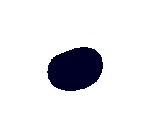






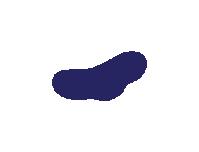
open in Jacksonville. This is the
store in the US, as well as
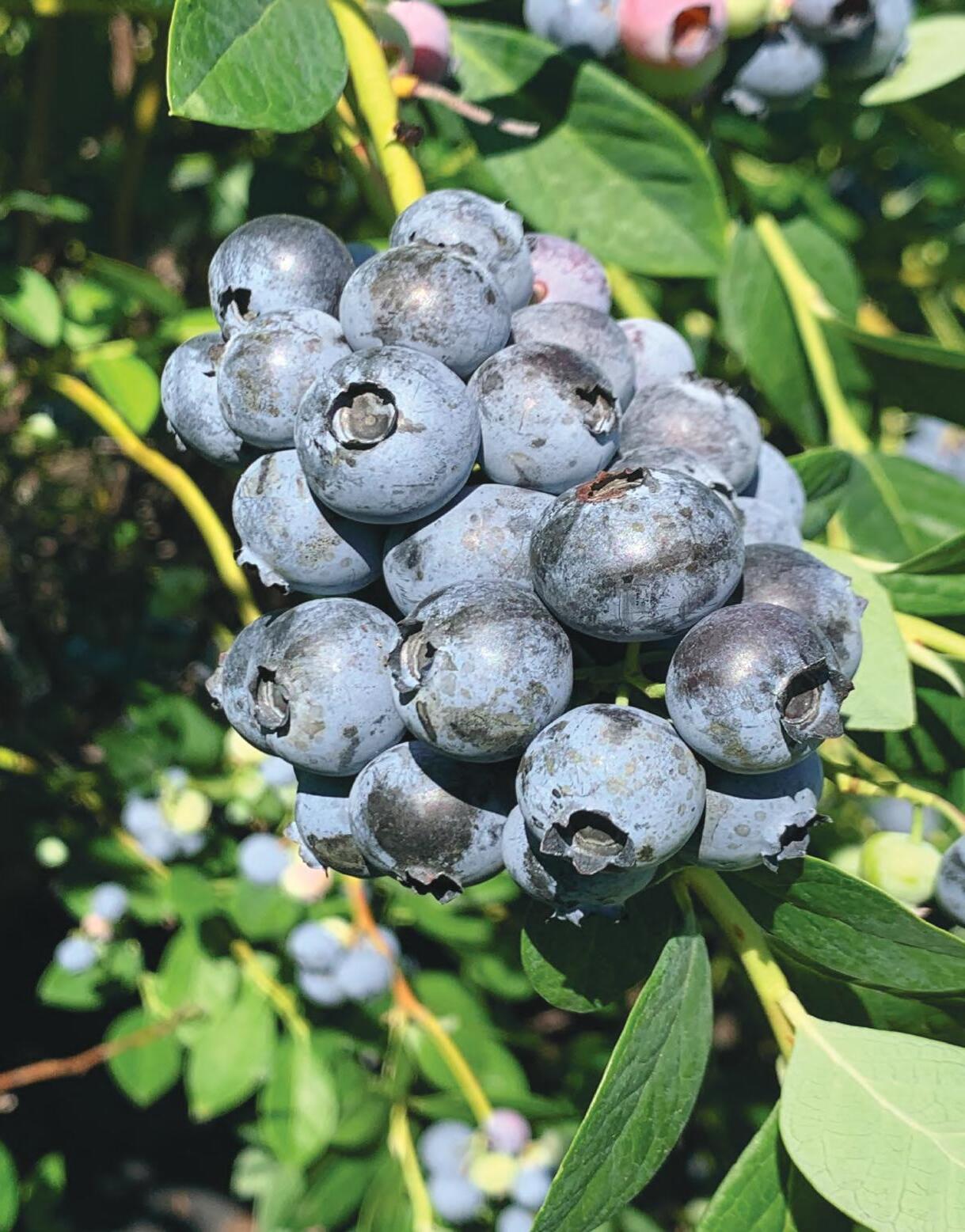
first in the state and
US. It opened



the public on March 18, 2017. Jacksonville is the most populous city in the Sunshine State, as well as home to the largest FilipinoAmerican community in Florida. The longawaited arrival of Jollibee in the city has

HARVEST THE ENDORSED PUBLICATION OF THE FLORIDA BLUEBERRY GROWERS ASSOCIATION www.FloridaBlueberryGrowers.org volume
TOPIC OF THE SEASON Management Strategies From Preharvest Through Post-Harvest
PRUNING Strategies for New and Mature SHB, Plus Rejuvenation Tactics POST-HARVEST PRIMER Get an Edge on Summer Fungal Leaf Diseases TOP THREAT Mitigating Damage From Chilli Thrips PRSRT STD US POSTAGE PAID WEST PALM BEACH,FL PERMIT NO. 4595 ipation and
largest
11 | issue 3 | spring 2022
PRUDENT
excitement, Jollibee, the
Asian restaurant
now
36th
the
Southeast
to
With the opening, Floridians will get to try Jollibee's signature menu items such as the world famous Chickenjoy. This dish is delicately breaded to be crispylicious on the outside and juicylicious inside. The well-loved Jolly Spaghetti is a favorite of both kids and kids-at-heart because of its signature sweetstyle sauce, loaded with chunky slices of savory ham, ground meat, and hotdog. Other classic menufavorites include the juicy and cheesy Jolly Hotdog, and the Peach Mango Pie, which is made with real Philippine sweet mangoes and a flaky golden brown crust. edition
8 PRUDENT PRUNING
Pruning is a recommended practice in southern highbush blueberry (SHB) production. The many benefits of pruning include maintaining and balancing vegetative and reproductive growth, reducing the incidence of pests and disease, improving overall plant structure, controlling plant size, facilitating spraying and harvest practices, and reducing limb breakage, just to name a few.
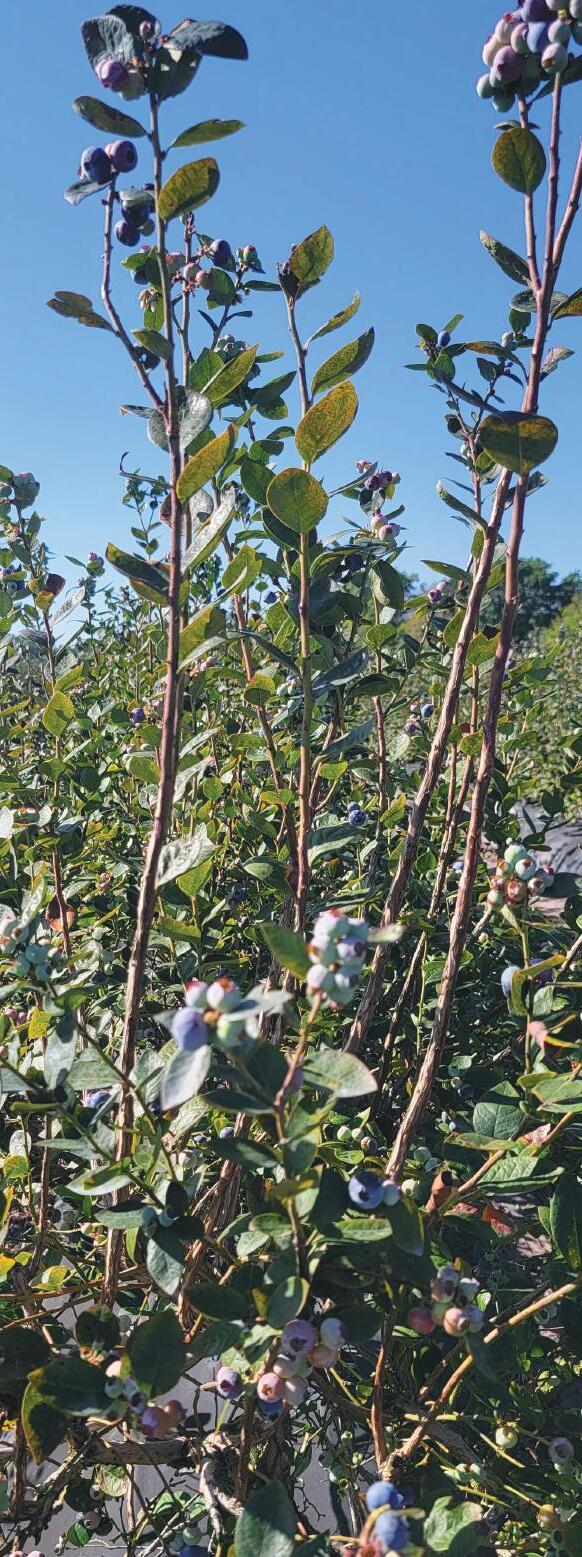
10 PLAN TO CELEBRATE AND CAPITALIZE ON NATIONAL BLUEBERRY MONTH
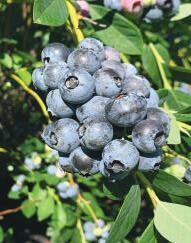
It’s April, which means National Blueberry Month is just three months away! The U.S. Highbush Blueberry Council is gearing up for an epic celebration. Throughout the month of July, USHBC will be unleashing the power of blueberries nationwide and inspiring consumers to show how blueberries give them a boost. The campaign will connect blueberries to the best parts of everyday life, driving engagement and demand.
28 TOP THREAT











Chilli thrips are a significant pest on southern highbush blueberries in Florida with the potential to cause heavy foliage damage from late spring through early fall. Although there are insecticides with efficacy on chilli thrips, the number of applications used and cost of products have become a significant management issue for Florida growers.
30 POST-HARVEST PRIMER
Growers have many tools from which to choose when orchestrating their post-harvest plan to keep bushes healthy. These can range from horticultural inputs to selecting which and when to apply numerous fungicide product options. Hedging (pruning away the old canes) resets the plants to produce a flush of young canes and new leaves. Leaves hang around until winter in deciduous production, and through the next harvest in evergreen. Learn more about some summer fungal leaf diseases and how to manage them.

2 | The Blueberry News 4 Executive Director's Letter 6 President's Letter 10 USHBC Update 11 Topic of the Season 15 App Update 17 Angle Letter 20 Grower 411 27 Publisher’s Interlude 28 Bug of the Month 33 Classifieds ON THE COVER As growers throughout the state harvest the season’s berries, like these at Florida Blue Farms, additional challenges come in the form of freezes, prices, and pests. photo by BRITTANY LEE HARVEST THEENDORSEDPUBLICATIONOF THEFLORIDABLUEBERRYGROWERSASSOCIATION www.FloridaBlueberryGrowers.org volume11|issue3|spring2022 TOPIC OF THE SEASON ManagementStrategies FromPreharvestThrough Post-Harvest PRUDENT PRUNING Strategies for New and Mature SHB, Plus RejuvenationTacticsPOST-HARVEST PRIMER Get an Edge on Summer Fungal Leaf Diseases TOP THREATMitigating Damage From ChilliThrips Appetizer s: Entrées: Advertisers Directory 2 Appell Pie 2 Calendar Events 10 Classified Ads 14 What’s Going On 3 Analysis:Cateringindustryrevenuesontherise 4 “Big Data” — Doesyourrestaurantneedit? 7 RiseBisquitsDonutstoopeninCoralSprings 11 Del Taco spices up expansion in the Southeast 13 STDPRSRT POSTAGEPAID BEACH,FLPALMWEST 4595NO.PERMIT WWW.TRNUSA.COM VOLUME 21 NUMBER 3 ◆ MARCH 2017 FLORIDA’S FOODSERVICE INDUSTRY NEWSPAPER ◆ $3 FLORIDA EDITION Jollibee's U.S. expansion continues with first Florida location opening Jacksonville, FL After much anticipation and excitement, Jollibee, the largest Asian restaurant company, is now open in Jacksonville. This the 36th store in the US, as well as the first in the state and Southeast US. It opened to the public on March 18,2017.Jacksonvillethemostpopulouscityin the Sunshine State, as well as home to the largest FilipinoAmerican community in Florida. The longawaited arrival of Jollibee in the city has "As Jollibee debuts in Florida, we anticipate seeing not only multitude of excited Jollibee patrons waiting to get their hands on their Jollibee favorites, but also first-timers waiting to have their own Jollibee experience," said Jose Miñana, Jollibee Foods Corporation's Group President for North America. "There's no greater joy for us than serving the needs and tastes of Jollibee fans in the community. At Jollibee, we aim to bring families together for happy moments over great tasting food with superior value, served with warm and friendly service our own brand of joy."Thebrand has become symbol of nostalgia and warm childhood memories for many overseas Filipinos in the U.S. To many, Jollibee is the go-to restaurant of Filipinos for both special been the talk of the town since 2016. With the opening, Floridians will get to try Jollibee's signature menu items such as the world famous Chickenjoy. This dish is delicately breaded to be crispylicious on the outside and juicylicious inside. The well-loved Jolly Spaghetti a favorite of both kids and kids-at-heart because of its signature sweetstyle sauce, loaded with chunky slices of savory ham, ground meat, and hotdog. Other classic menufavorites include the juicy and cheesy Jolly Hotdog, and the Peach Mango Pie, which made with real Philippine sweet mangoes and flaky golden brown crust. See JOLLIBEE page 15 and sustainable sourcing, local and seasonal produce, and global flavors and forms, all done within the steakhouse format showcasing cuts of meat as entrées with choice of sides. Moreover, new menu categories (such as flatbreads) and service elements freshen the concept. About the Report 2017 Forecast: Culinary Trend Tracking Series offers an outlook on the culinary trends—the foods, dishes, ingredients and flavors—that Packaged Facts expects to grow in popularity in 2017. Rockville, MD When it comes to American cuisine, there are few things more iconic than steakhouses. The slabs of marbled meat, the sizzling grills, the oozing butter, and the dripping bravado, maybe even a cowboy hat or two for ambiance—it's enough to make even fictional steakophile Ron Swanson misty-eyed. Yet for all the traditional steak dinners ordered daily, there are restaurants nationwide pushing the concept of the all-American steakhouse to new culinary heights, according to market research firm Packaged Facts in the brand new report 2017 Forecast: Culinary Trend Tracking Series. "The steakhouse is back and will capture our attention in 2017. Not that the classic restaurant style ever disappeared, but renewal of the model is taking place in response to new sources of beef and new flavorful expressions of the concept that get chefs and diners excited," says David Sprinkle, research director, Packaged Facts. Today's steakhouse menus increasingly feature grass-fed cattle, locally raised animals, heritage varieties, meat butchered and dry aged in-house, and dishes that stem from the whole animal, not just the premium cuts. And that's just the meat. Creative side dishes in lieu of old standards, global and seasonal flavors, and wider menu selection also distinguish these new school operations. Chefs and consumers both want their meat to taste delicious and to feel good about its’ consumption, too. This new breed of steakhouse broadcasts its mission to support local ranchers, factor in sustainability and animal welfare, and create dining experience that showcases culinary flair, not just grill master's skill at cooking steak to the requested doneness. These operations are also designed to be more inclusive, more of a great place for all kinds of people to dine well, not just traditionminded men on expense accounts. As a result, the modern steakhouse increasingly similar to other modern restaurants with focus on distinctive 2017 forecast:Steakhouses beef up menus with new twists on American classics See STEAKHOUSE page 11 edition
fieldsequip.com 3203 HAVENDALE BLVD WINTER HAVEN, FL 33881 863-967-0602 3440 US HIGHWAY 17 SOUTH ZOLFO SPRINGS, FL 33890-0837 863-735-1122 17215 HIGHWAY 27 NORTH MINNEOLA, FL 34715-9273 352-394-7181 John Deere 3025E tractor 300E Loader RC2060 Rotary Cutter 20’ Car Hauler Trailer “Nothing Runs Like a Deere” Test Drive One Today! Package Deal Only $28,827.00 ASK ABOUT ALL OF OUR TRACTOR PACKAGES


FloridaBlueberryGrowers.org The Blueberry News | 3 When one cold night can ruin an entire year’s hard work... It’s best to play it safe. Since 1967, we have hand-crafted our wind machines with precision technology. We take pride in the details, which is why blueberry growers from around the world trust Orchard-Rite® wind machines to protect their mature stock and new plantings from the dangers of frost. We are dedicated to serving you and your crops by providing the tools, knowledge and service to stave off those frosty nights, protecting your harvest and your future. Superior Wind Machine Sales & Service 616-971-8177 orchard-rite.com Authorized Distributor of Orchard-Rite® Wind Machines SUPERIOR WIND MACHINE SERVICE, INC. Over 37,000 SOLD Worldwide!
Showcasing Florida’s Blueberry Industry

IT IS HARVEST SEASON 2022, and we have already had quite a packed spring in Florida!
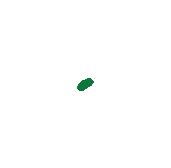
March has been a great month to showcase the Florida Blueberry industry, starting with the joint meeting of the U.S. Highbush Blueberry Council and North American Blueberry Council in Tampa.
The conference featured panel discussions focused on how our industry can drive more volume through foodservice and food manufacturing channels. This was followed by a food demonstration showcasing a behind-the-scenes look at USHBC’s foodservice-innovation process.
Dr. Patricio Munoz participated in the Flavor Time session with several other industry leaders to discuss the UF/IFAS blueberry breeding and genomics lab and how the industry is driving future consumption through flavor innovation.
Attendees were able to see three top operations, visiting Astin Farms, Wish Farms, and Frogmore Fresh.
The week ended with committee meetings that were focused on the 2021-2025 strategic plan and the programs USHBC is working on in the coming years.
In addition to the USHBC/NABC Farm tour, Doug Phillips and Munoz hosted a Field Day touring A&A Farms in Arcadia and Frogmore Fresh in Dade City.
The tour highlighted several UF/IFAS Stage 3 and Stage 4 selections, as well as other varieties that are commonly grown in each area and the UF Mechanical Harvesting trial selections at Frogmore.
Florida continues to be the cornerstone of the domestic market, and we have been able to showcase the progressive measures our state industry and growers have been taking to differentiate ourselves in the marketplace!
Brittany H. Lee, Executive Director,
Florida
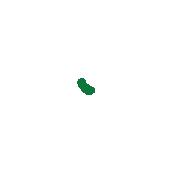


 Blueberry Growers Association
Blueberry Growers Association



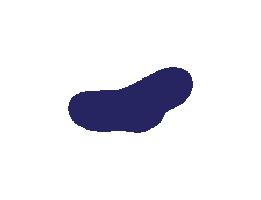
fbga.ed@gmail.com
PUBLISHER
Nelson Kirkland
MANAGING EDITOR
Jessica McDonald
DIGITAL ACCOUNT MANAGER
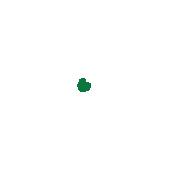
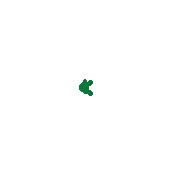

Alexis Duncan
ACCOUNT EXECUTIVE


Juanita Halter
LIAISON EDITORS
Brittany H. Lee, Doug Phillips, Jeff Williamson
CONTRIBUTING WRITERS
Doug Phillips, Jeff Williamson, Peter Dittmar, Jeff Williamson, Jenni Sparks, Oscar Liburd, Phil Harmon
CONTRIBUTING PHOTOGRAPHERS
Brittany Lee, Doug Phillips, Jeff Williamson
CONTRIBUTING ARTISTS
Dawn Lewandowski
DELIVERY
DLS Distributors
be held responsible, nor do the publishers accept any liability for the accuracy of statements made by advertisers in advertising and promotional materials. Furthermore, the opinions and claims expressed in advertisements and promotional materials do not necessarily reflect those of the Florida
advertisers
4 | The Blueberry News FloridaBlueberryGrowers.org executive director’s letter
www.FloridaBlueberryGrowers.com Published by Central Florida Media Group in cooperation with the Florida Blueberry Growers Association Copyright © 2022 Central Florida Media Group. ALL RIGHTS RESERVED. This issue of The Blueberry News is a trademark of Central Florida Media Group. Reproduction or use in whole or in part of the contents of this magazine without written permission is prohibited. The Blueberry News makes every effort to ensure the accuracy of content published. In the event of an
the
or
56 Fourth Street Northwest, Suite 100 Winter Haven, Florida
863.248.7537
error found herein however, neither
publishers
will
PHONE
Brittany H. Lee
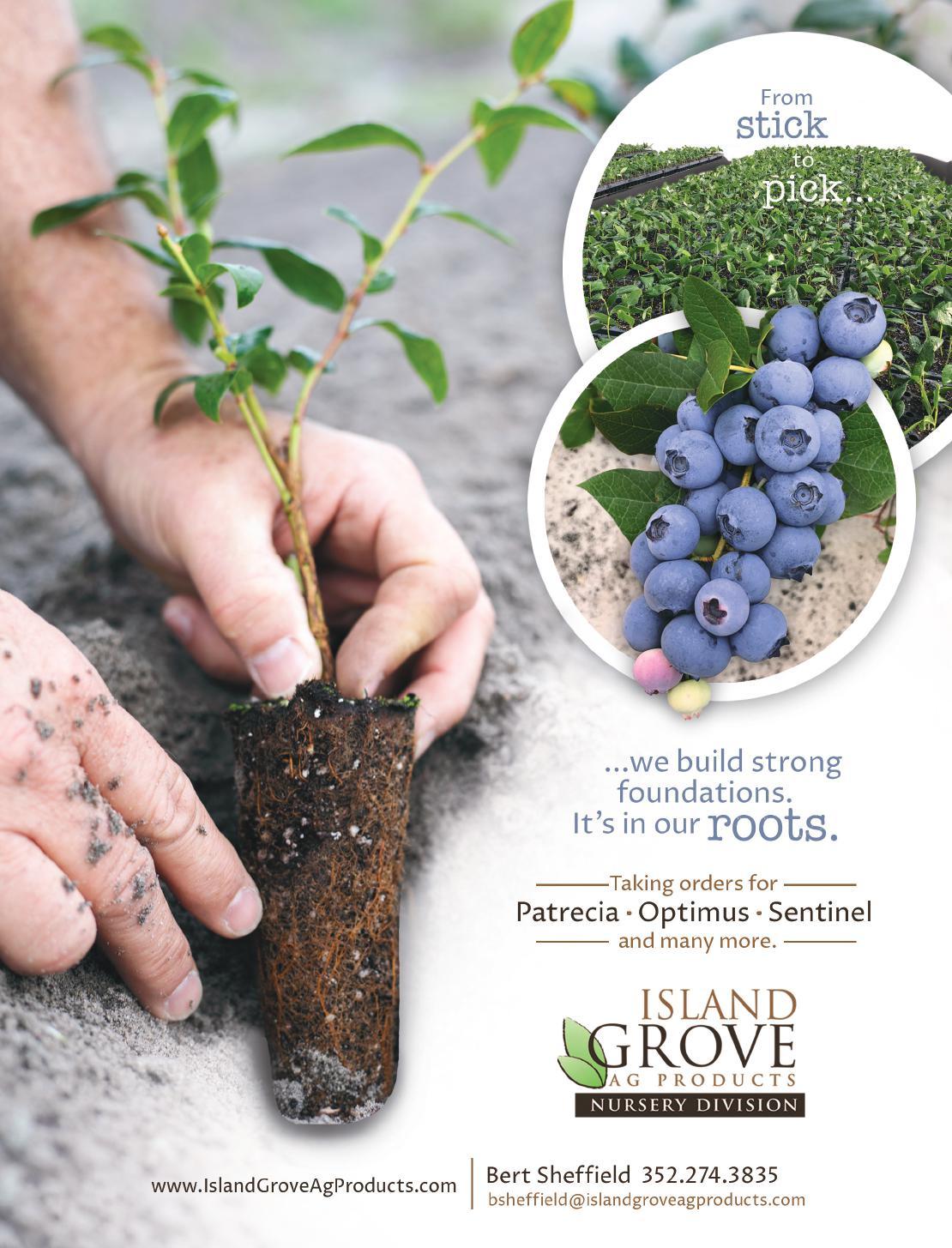
FloridaBlueberryGrowers.org 5
P.O. BOX 358086

Gainesville, FL 32635







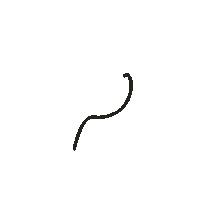
352-448-1418


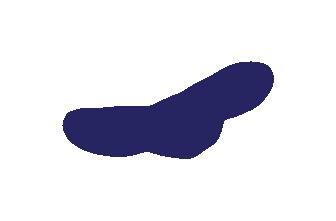
OFFICERS
Brittany Lee, Executive Director fbga.ed@gmail.com
Leonard Park, President president.fbga@gmail.com
Jerod Gross, Vice President fbga.vp@gmail.com
Michael Hill, Secretary michael@handafarms.com
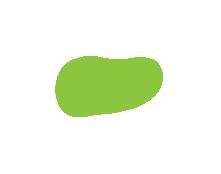
Bobby Barben, Treasurer rhbjr@barbenfruit.com
BOARD OF DIRECTORS
Wayne Bass
Jerod Gross
Phil Harmon
Gary Smith
Kyle Straughn
Jeff Williamson
Doug Phillips
Travis Kuhn
Dealing With Mother Nature and the Designs of Society
As I pen this in mid-March, I’m not sure how the season will turn out, but I’m hopeful and as ready as I can be for what comes at harvest. Ever since Thanksgiving, our business has been steering through white waters I hardly expected to see till harvest. As growers, you know it’s been a bit of an odd year due to both the political and economic designs of our society and the inescapable influence of Mother Nature. Despite this, the Florida growers I talk to have all been working hard and figuring out how to adjust their operations to capture a good harvest.
Our farm, Frogmore Fresh, is about 35 miles north of Tampa in a coolish hilly microclimate. Some of you Florida growers had different weather impacts from ours, but we all dealt with similar human-driven economic impacts. Some were challenges, and some were beneficial.
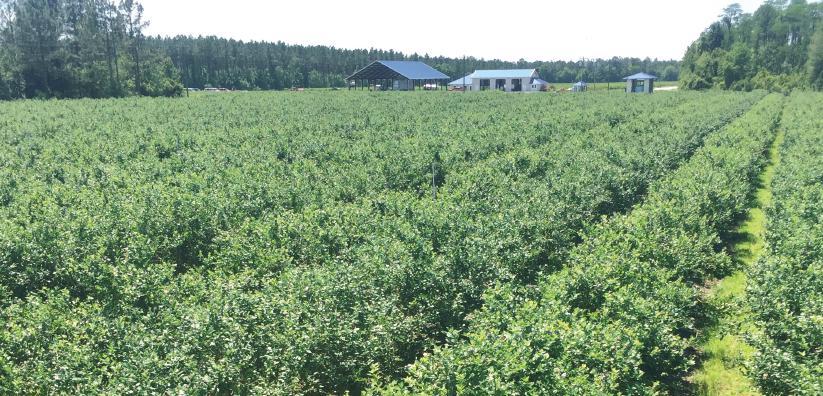
Designs of Society
Three notable issues, in particular, added to the cost of operations layered on top of the already accelerating inflation picture. Supply chain inflation went into high gear this spring as the politics of energy teamed up with Russia’s war on Ukraine. Growers are getting hit with the double whammy of jumping fuel costs and surging prices for their critical nutrients and crop protection chemicals. These are substantial double-digit percentage increases, and the impact of this trend will hit our 2023 crop for its entire growing season. Prices are not stable, leading to an uncertain planning environment. Of course, these issues may impact our foreign competition even more. Import costs shot up, and shipping delays hurt fruit quality. This is a mixed blessing that may make our blueberries more competitive but, at the same time, turn off consumers to blueberries as a favorite food category. Let’s hope that consumers respond to the better tasting “Fresh From Florida” blueberries we are growing nearby. I know the market is anxiously awaiting our crop of quality berries.
Influence of Mother Nature
Despite all the challenges society places on farming businesses, none compare to the dictates of Mother Nature. Southern Highbush Blueberries are a demanding crop to grow in Florida, with 12 months of active caretaking required and every bug and microbe hungry for some part of them. Even after growing a nice bush loaded with lots of flower buds, winter weather has the last say. For our farm, we had very few December chill hours. Other growers had the same experience, suggesting a lighter than average crop for legacy varieties. For us, the warmth of early winter helped early season varieties and those with evergreen production culture. This looks like a good year for recent plantings of newer UF varieties… if you had good frost protection.
We stayed up eight nights running overheads; more than the last several years combined. For the most part, we were successful with limited freeze damage. I know some of you did so more than 10 times, which can wear a person down even before the rigors of harvest arrive. Frost events can put a dent in the crop totals, and I’m sure Florida did not escape entirely, but our friends in Georgia took a few hard hits. Let’s hope they come through okay and that firmer prices to all Southeast growers will help offset the designs of society and the influence of Mother Nature
Leonard Park President Florida Blueberry Growers Association


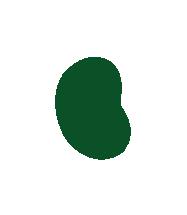
6 | The Blueberry News FloridaBlueberryGrowers.org
president’s letter

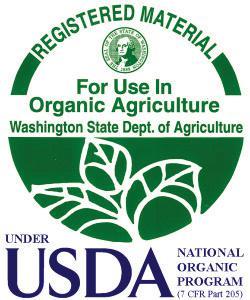

FloridaBlueberryGrowers.org The Blueberry News | 7 KeyPlex P.O. Box 2515, Winter Park, FL 32790 Local/Int’l: +1-407-682-6500 Toll Free: 1-800-433-7017 Fax: +1-407-682-6504 E~Mail: keyplex@keyplex.com Visit KeyPlex.com for Crop KeyCards, Knowledge and Information W Micronutrients KeyPlex P.O. Box 2515, Winter Park, FL 32790 Local/Int’l: +1-407-682-6500 Toll Free: 1-800-433-7017 Fax: +1-407-682-6504 E~Mail: keyplex@keyplex.com Visit KeyPlex.com for Crop KeyCards, Knowledge and Information W unloCK the SecretS of plant health & diSeaSe control Invest in your return today Micronutrients
Prudent Pruning Strategies for New and Mature Southern Highbush Blueberries
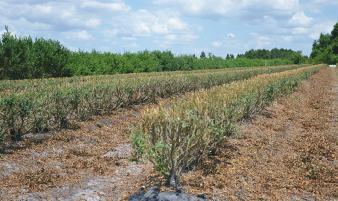

Pruning is a recommended practice in southern highbush blueberry (SHB) production. The many benefits of pruning include: maintaining and balancing vegetative and reproductive growth, reducing incidence of pests and disease, improving overall plant structure, controlling plant size, facilitating spraying and harvest practices, and reducing limb breakage, just to name a few.
Pruning may be done at different times of the year depending on the goals and objectives, but most routine pruning of SHB is done in the late spring, soon after the end of the harvest season. Delaying postharvest pruning until mid to late summer may reduce the number of flower buds that initiate on the regrowth that are needed for next year’s production. A major goal of postharvest pruning is to stimulate vegetative growth during the summer and establish a healthy, diseasefree, canopy entering late summer or early fall, which is the major period for flower bud initiation (FBI) of SHB in Florida. Both shortened day lengths (long uninterrupted dark periods) and cooler temperatures stimulate FBI. These conditions occur during the transition to fall and early winter. The timing of blueberry FBI in Florida varies with cultivar and year but may begin as early as August on some cultivars and continues through late fall or early winter.
Research showed that “Emerald” FBI
began in August while “Jewel” did not begin significant FBI until October. Leaves perceive the changing environmental conditions, so it is critically important that adequate new growth with healthy, disease-free leaves be present during this period to develop adequate flower buds for next year’s crop. Premature defoliation in early to mid-fall has been shown to significantly reduce the number of flower buds formed as well as the average number of florets within each flower bud.
Mature plants
As stated above, most pruning of mature plants is done soon after harvest is complete, giving as much time as possible for regrowth before terminal bud set in the fall. Generally, postharvest pruning is non-selective and done mechanically to reduce labor costs. Various types of mechanical pruners can be used to hedge and top blueberry plants (Photos 1 and 2).
Topping height of a mature plant will vary considerably but generally will be between 40-48 inches, which allows for easy access to fruit during harvest. Many growers hedge straight across the top (Photo 3) but others prefer a “rooftop” cut angled about 45 to 55 degrees up to a point in the center of the plant canopy. Most SHB cultivars respond well to hedging and topping, however, there are exceptions such as “Chickadee,” which can struggle to achieve significant regrowth following hedging and topping. For “Chickadee,” light tipping instead of usual pruning has been beneficial in some cases. Alternatively, some cultivars tend to develop vigorous upright shoots in response to pruning. One or two followup tippings on vigorous upright shoots may increase branching and the amount of fruiting wood, but should be done in time to allow for regrowth to maturity
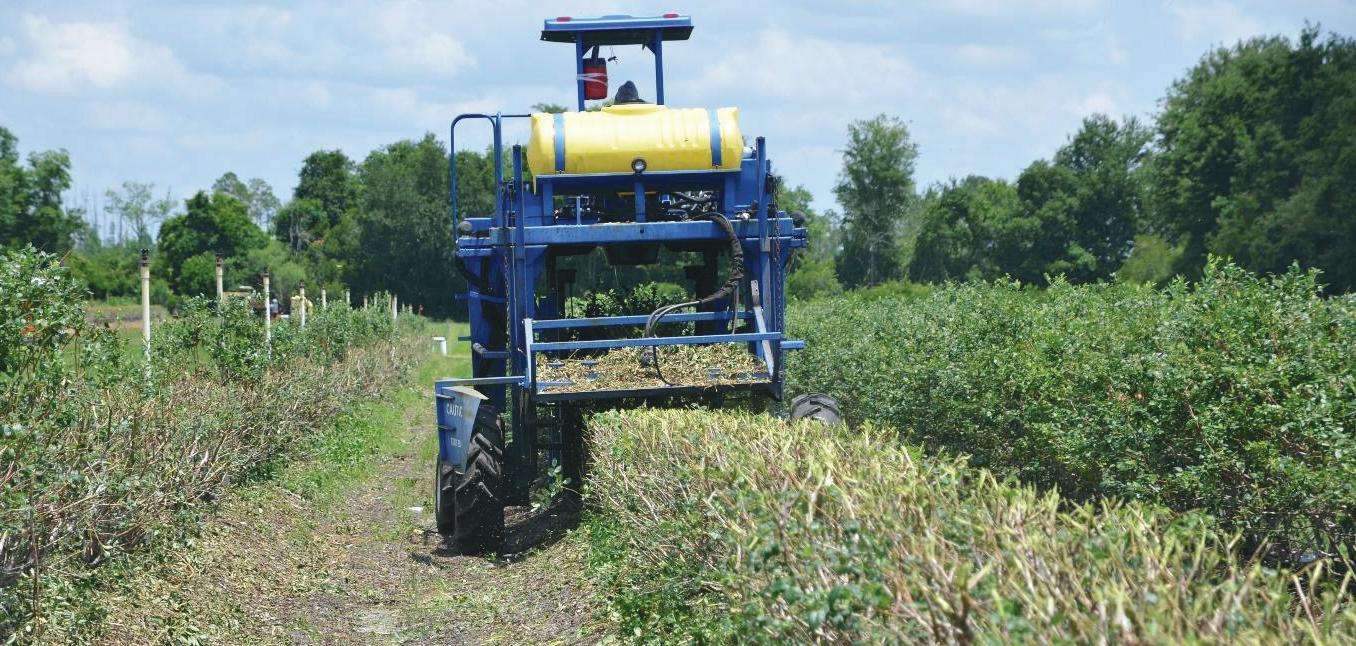
8 | The Blueberry News FloridaBlueberryGrowers.org field management
Photo 1. Bennetts BTS chopper over-the-row mechanical hedger/topper. Photos by Jeff Williamson.
Photo 2. A flail hedger that cuts in one plane at a time is used here to prune riser rows.
Photo 3. A southern highbush blueberry field that was recently hedged and topped.
before the fall/winter season. Crews may follow the mechanical pruning operation to “clean-up” (remove pruning debris, broken shoots, and diseased or damaged wood) and possibly “base prune” (remove one or two of the older canes near the crown) older plants. If mechanical harvesting is an option, efforts to keep the crown as narrow as possible are usually employed. Pruning cuts can be sites for fungal infections and pruning should be immediately followed with a broad spectrum fungicide spray (Photo 4).
growers have harvested fruit from young plants within the first 12 to 18 months after planting. Therefore, the extent of flower bud removal from young plants is dependent on cultivar, management system, and plant establishment.

Machine harvesting
Hand harvesting is the single greatest production expense for SHB. Many growers are considering machine harvesting as a more cost-effective alternative to traditional hand harvesting. Even if there are no immediate plans for machine harvesting, keeping that option open may be beneficial in the future. With current machine harvesting technology, considerable fruit will be dropped on the ground during harvest if plants are not trained to narrow crowns (Photo 6).
Pruning and training new plants
Traditionally, 1/3 to ½ of the tops of young blueberry plants are often removed at planting to minimize transplant stress and facilitate good plant establishment. The extent of pruning at planting will depend on the plant condition and the care that it receives following planting. Tall, leggy, or rootbound plants may require more top removal than smaller nursery plants. Historically, it has been common to remove flower buds from plants at planting followed by some flower bud thinning the following year depending on the extent of plant establishment in year one. In intensively managed fields of vigorous cultivars, and under the evergreen production system,
If machine harvesting is an option, special consideration should be given to training plants to narrow crowns. This training should begin at planting. Juice or milk cartons are often used at planting to assist in training young plants to narrow crowns (Photo 7). Some growers have begun using plastic sleeves with fiberglass stakes, both of which can be reused (Photo 8). Once the cartons or sleeves are removed, some maintenance pruning will be required to maintain narrow crowns as plants mature (Photo 9).
Rejuvenation pruning

Older plants that have not been pruned for several years tend to lose vigor and become non-productive. If the plants are otherwise healthy, it is possible to rejuvenate the plants through aggressive pruning. All canes are cut back to 1 to 2 feet either in the late spring/early summer or during late winter just before they emerge from dormancy. If plants are low vigor due to overall poor health or a cultivar with low inherent vigor, rejuvenation pruning will probably not result in a positive outcome. Even with a successful outcome, rejuvenation pruning will likely result in a significant reduction in productivity for one to two years. Using rejuvenation pruning on only a portion of the field over a period of years will help maintain some level of productivity during the process.
For more information on pruning SHB in Florida, please see Pruning Southern Highbush Blueberry in Florida, https://edis.ifas.ufl. edu/pdf/HS/HS135900.pdf.

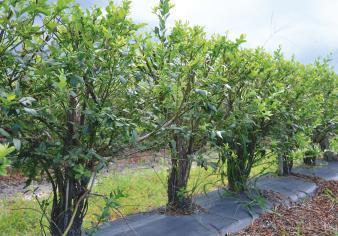
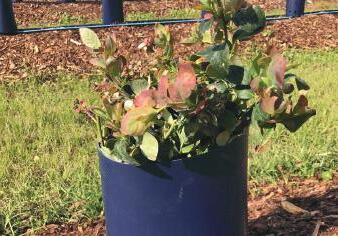
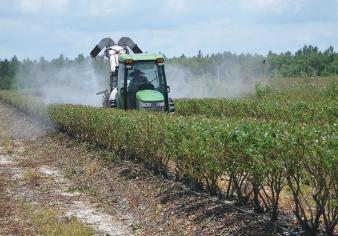 Horticultural Sciences
Horticultural Sciences

FloridaBlueberryGrowers.org The Blueberry News | 9
_ _____ CREDIT JEFF WILLIAMSON,
Department, UF & DOUG
PHILLIPS,
UF/IFAS Blueberry Extension Coordinator
Photo 7. Recently planted southern highbush plants trained to a narrow crown with cartons.
Photo 4. A broad-spectrum fungicide spray is applied immediately after hedging and topping.
Photo 8. Plastic sleeve used to train blueberry plants to have a narrow crown.
Photo 9. These plants were trained to a narrow crown with cartons. The narrow crowns will increase harvest efficiency with machine harvesters.
Photo 5. Regrowth of southern highbush blueberry following postharvest hedging and topping.
Photo 6. A southern highbush blueberry plant that was not trained for machine harvesting. Note the large number of berries dropped by the harvester and the damage to canes from harvester catch plates.
USHBC Update
Plan to Celebrate And Capitalize on National Blueberry Month
It’s April, which means National Blueberry Month is just three months away! The U.S. Highbush Blueberry Council (USHBC) is gearing up for an epic celebration.
Throughout the month of July, USHBC will be unleashing the power of blueberries nationwide and inspiring consumers to show how blueberries give them a boost. The campaign – which includes media relations, social media activations, and experiential marketing – will connect blueberries to the best parts of everyday life, driving engagement and demand. Even better, it’s all for a good cause: As part of the month-long celebration, USHBC is partnering with No Kid Hungry to provide kids in need up to 500,000 meals during the month. Each social post by consumers about blueberries throughout July will equal a $1 donation to help feed kids in need.
Florida growers can get involved this summer by taking part and engaging with USHBC resources and activities. Download the resources in the National Blueberry Month toolkit – available at ushbc.org/toolkits — which will be updated with new marketing tools and promotional ideas throughout April to give you plenty of time to plan your July
marketing.
The toolkit offers social media graphics, digital materials, new recipes, and even a fun 31-Day Challenge that you can use to engage your audiences and encourage consumer participation in unique ways all month long. Keep an eye on USHBC’s Facebook and Instagram pages @blueberries for lots of inspiration and ideas.
“A collective effort to get consumers to ‘grab a boost of blue’ during the month of July will pay off big for the blueberry industry,” says USHBC V.P., Marketing & Communications Jennifer Sparks. “Taking advantage of this timely opportunity to spotlight blueberries helps to turn blueberry consumers into blueberry enthusiasts.”
Capitalize on National Blueberry Month to Generate News

What more can Florida growers do on a local level? Engage your local media. Generating news coverage is a powerful way to capture consumers’ attention and get them thinking about blueberries. Reporters are more likely to cover news that is timely and local.
“Working with the media is also
an opportunity to establish your business as the local expert, which helps you establish thought leadership with your customers, community, and stakeholders,” says Sparks. “While USHBC is working to garner media coverage nationwide, Florida growers can use National Blueberry Month as a timely opportunity to capture the attention of local media.”
USHBC offers these media-savvy tips:
HOST A MEDIA EVENT
• Tie in with National Blueberry Month Community event: Are you planning any community events or tours during National Blueberry Month? Let the media know! Even if you are not a U-pick farm, consider opening up your farm for a day where kids and families can come to learn about how blueberries are grown. People like to be educated about the food they love. If your crop isn’t at peak, you can still plan fun Blueberry Month activities for kids and showcase blueberry tips, facts, and recipes. It’s all about using National Blueberry Month as an opportunity for your business to tie into a timely calendar event. Send a media advisory via email with the “who, what, where, when”
10 | The Blueberry News FloridaBlueberryGrowers.org
38
continued on page
Management Strategies From Preharvest Through Post-Harvest
by DOUG PHILLIPS, UF/IFAS Blueberry Extension, JEFFREY G. WILLIAMSON, Horticultural Sciences Department, PHILIP F. HARMON, Department of Plant Pathology, OSCAR E. LIBURD, Entomology and Nematology Department, and PETER DITTMAR, Horticultural Sciences Department, all with the University of Florida/IFAS.



The following tables were updated from the 2022 UF/IFAS Florida Blueberry Integrated Pest Management Guide found at edis.ifas.ufl.edu/hs380. This publication is intended for use only as a guide. Specific rates and application methods are on the pesticide label, and these are subject to change at any time. Always refer to and read the pesticide label before making any application! The pesticide label supersedes any information contained in this guide, and it is the legal document referenced for application standards.
POLLINATOR PROTECTION
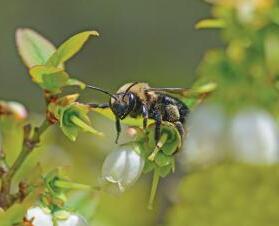
Before making insecticide applications, monitor insect populations to determine if treatment is needed. If insecticide application is necessary:
1. Use selective pesticides to reduce risk to pollinators and other non-target beneficial insects.
2. Read and follow all pesticide label directions and precautions. The label is the Law! EPA now requires the addition of a “Protection of Pollinators” advisory box on certain pesticide labels. Look for the bee hazard icon in the Directions for Use and within crop specific sections for instructions to protect bees and other insect pollinators.
3. Minimize infield exposure of bees to pesticides by avoiding applications when bees are actively foraging in the crops. Bee flower visitation rate is highest in early morning. Apply pesticides in the late afternoon or early evening to allow for maximum residue degradation before bees return the next morning. Bee foraging activity is also dependent upon time of year (temperature) and stage of crop growth. The greatest risk of bee exposure is during bloom.
4. Minimize off-target movement of pesticide applications by following label directions to minimize off-target movement of pesticides. Do not make pesticide applications when the wind is blowing towards bee hives or off-site pollinator habitats.
PREHARVEST FRUIT
ALTERNARIA AND ANTHRACNOSE FRUIT ROTS
Alternaria fruit rot occurs most frequently when fruit is not timely harvested and remains on the bush for too long. Symptoms include darkgreen to black sporulation on ripe fruit and sunken areas near the calyx end of the berry. In postharvest storage, green to gray fuzzy growth may appear on infected fruit, especially if the berries have remained wet or were not properly cooled. Preventive fungicide applications can be made to help minimize disease development.
Anthracnose fruit rot is also referred to as "ripe rot." Infection may occur as early as bloom, with symptoms appearing as the fruit begins to ripen, including shriveling, development of sunken lesions, soft, rotted fruit, and eruption of orange- or salmon-colored spore masses on the blossom end of the fruit. In some cases, symptoms do not appear until after the fruit is harvested and stored. Fungicide applications from bloom through harvest prevent significant ripe rot losses most years when coupled with frequent hand-harvesting and rapid-cooling practices that are standard for southern highbush blueberry growers in Florida. Preharvest fungicides are especially important in years where there is a high incidence of disease in the field coupled with warm, wet weather, which can promote disease development. See Table 1 and EDIS publication PP337, “Anthracnose on Southern Highbush Blueberry” (https://edis.ifas.ufl.edu/publication/PP337).
HARVESTED FRUIT
ALTERNARIA AND ANTHRACNOSE FRUIT ROTS
See discussion above. Pre- and postharvest rots can be greatly reduced by timely, complete harvest of all ripe fruit on the bush, followed by rapid postharvest cooling. For hand-harvested highbush and southern highbush cultivars, harvest all ripe berries on the bush every 7 days or less. Rabbiteye cultivars should be clean-harvested every 10–14 days. Postharvest cooling is critical and is best accomplished through the use of partial-vacuum or forced-air systems that use fans to pull cold air through stacks of palletized fruit. See Table 1.
continued on next page
FloridaBlueberryGrowers.org The Blueberry News | 11 topic of the season
topic of the season
continued from previous page
HARVESTED FRUIT, CONT.
BLUEBERRY MAGGOT
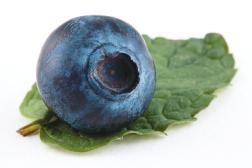
Blueberry maggot (BBM) is only a problem for growers north of the Lake City and Live Oak areas. Growers in Gainesville and south of Gainesville should not experience any problems with blueberry maggot. Blueberry maggot is a late-season pest. If berries are infested with BBM, a whitish maggot will appear in the fruit at harvesting. The adult fly that lays the eggs can be monitored by hanging yellow sticky traps (baited with ammonium acetate) within the bush canopy, at least one per cultivar. Trap catches indicate when adults are present. Traps should be hung in the planting when berries begin to turn from full green to the greenish-pink stage. See your county Extension agent for identification pictures and further reference. If your planting has a history of BBM infestation, spray as soon as adults are trapped. Once spraying for BBM begins, it is very important to spray every 7–14 days until all the fruit has been harvested. All growers in Florida who are shipping blueberries to Canada or the United Kingdom must comply with appropriate guidelines for scouting, spraying, and postharvest inspection of berries, including a protocol for cooking samples of harvested fruit to test for the presence of the maggot in berries. The Canadian protocol states that blueberries must be certified maggotfree to enter Canada. See Table 2.
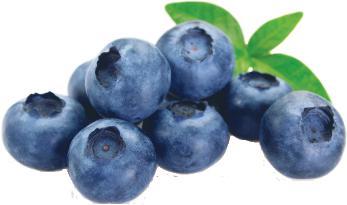
DIAPREPES (CITRUS ROOT WEEVIL)
Diaprepes larvae damage blueberry plants by feeding on the roots, including channeling and holes in the roots and feeding injury and girdling near the crown of the plant. Note that this damage is frequently observed some period of time after the larvae begin to feed on the roots, and at that point damage near the crown can appear similar to the effects of root girdling or mechanical wounding and abrasion. These injuries can kill or cause serious decline in blueberry plants and may also create an entry point for Phytophthora, causing a root rot infection. Management and control should target both the adult and larval stages. Control for adults consists of foliar insecticide sprays every 10–14 days when adults are active, beginning when 3 or more adults are found within 1-acre blocks. Larvae can be managed with insecticides either by directly drenching the soil area beneath the plant canopy or by applying them through drip or microjet irrigation systems. In addition, entomopathogenic nematodes may have potential for controlling root weevil larvae in blueberry. See Table 2 and EDIS publication ENY-999, “Diaprepes Root Weevil on Southern Highbush Blueberry in Florida” (https://edis.ifas.ufl.edu/publication/IN1241).
FLATHEADED BORERS
Flatheaded borers are a species of beetle in the Chrysobothrisgenus. The larvae tunnel through plant canes, ultimately killing the cane and acting as an entry point for disease. It is possible that adult beetles are attracted to stressed or damaged blueberry canes, with adult females laying eggs on the injured area, and larvae excavating tunnels just beneath the bark. This is a relatively new pest in blueberry, and research is ongoing regarding its life cycle, monitoring and trapping protocols, and control measures. See Table 2.
SPOTTED WING DROSOPHILA
Spotted Wing Drosophila (SWD) have been caught in all principal blueberry counties in Florida. Adults lay eggs in ripening blueberries, and larvae develop inside the berry, making the fruits soft and unmarketable. Adults can be monitored by placing traps in blueberry bushes. Traps can be made from plastic cups and baited with yeast sugar water. Traps should be placed within the canopy of the blueberry bush and not in direct sunlight. A number of insecticides have recently been registered for control of spotted wing drosophila. See Table 2 and EDIS publication ENY-861, “Spotted Wing Drosophila in Florida Berry Culture” (https://edis.ifas.ufl.edu/publication/IN839).
POSTHARVEST PLANTS
ALGAL STEM BLOTCH
Algal stem blotch is a blueberry disease caused by the parasitic green alga CephaleurosvirescensKunze, and it has become a significant disease on southern highbush blueberries in Florida. The alga is thought to enter the plant through natural wounds and openings, through pruning cuts, or by direct penetration of the cuticle. Early symptoms include small red blotches or lesions on green juvenile stems, with lesions expanding to form irregular cankers that can encircle canes. Bright-orange felt-like mats or tufts of algal growth appear from the lesions on young stems and older cane surfaces during summer and early fall when conditions are hot and humid. Leaves on symptomatic canes bleach white to pale yellow, and growth of the entire plant can be severely stunted as the disease advances. Leaf yellowing tends to occur on a few canes of each plant and is less uniform and blotchier than symptoms of nutritional deficiency. Algal stem blotch can lead to increased susceptibility to Botryosphaeria stem blight, in some cases leading to plant death. Plants that are stressed by abiotic or biotic factors are more susceptible to infection and subsequent disease development. To date, no systemic pesticide products have been found that will kill the algae living underneath the plant epidermis. Spray applications of coppercontaining fungicides can help to reduce algal sporulation and protect healthy canes from infection for a few days after application. However, these applications do not impact existing symptoms or eradicate the disease. See Table 1 and EDIS publication PP344, “Algal Stem Blotch in Southern Highbush Blueberry in Florida” (https://edis.ifas.ufl.edu/publication/PP344).
continued on page 14
12 | The Blueberry News FloridaBlueberryGrowers.org

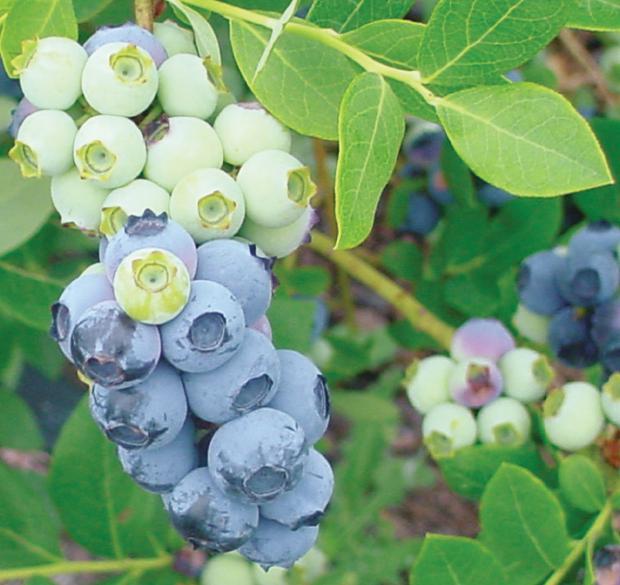

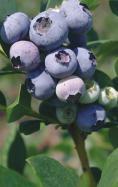

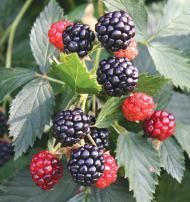
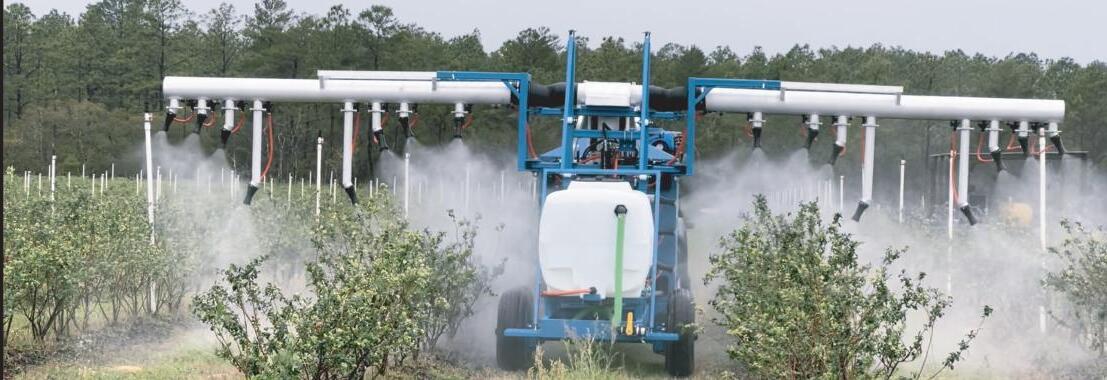
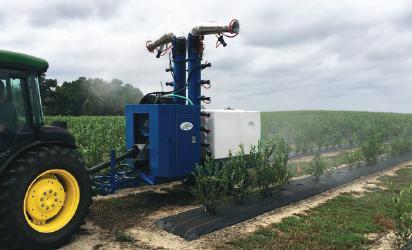




FloridaBlueberryGrowers.org The Blueberry News | 13 Virus indexed plants from tissue culture available in 72ct. cell packs & field ready liners. Agri-Starts, Inc. is a licensed propagator of Florida Foundation Seed Producers, University of Georgia Research Foundation, and University of Arkansas genetics. COME VISIT US ANYTIME! BLUEBERRIES BLACKBERRIES & MORE! AGRISTARTS.COM (407) 889-8055 - info@agristarts.com 1728 Kelly Park Rd. - Apopka, FL 32712 Agristarts Ad 7.5x5.indd 1 9/9/16 5:59 PM Type of Sprayers: • Air Boom • Cannon • Herbicide • Double Cannon • Skid w/Gun • Injection Trailers Models: • Single or tandem axle trailers • Tanks sizes - 100 to 500 gal. • Low profile & narrow designs • Single or double cannons ype 500 A irtec ISprayers nc Ask us about the latest cost share programs
topic of the season
continued from page 12
POSTHARVEST PLANTS, CONT.
ANTHRACNOSE LEAF SPOT, RUST, SEPTORIA, AND TARGET SPOT
Anthracnose, Septoria, rust, and target spot can cause premature defoliation, resulting in poor bud development and subsequent loss of yield. Fungicide timing for leaf spots varies across the state and by specific disease. Septoria can occur prior to harvest through late spring. Anthracnose leaf spots and target spots generally start postharvest and persist through summer. Rust is a problem in all Florida production areas. On susceptible varieties, rust can prematurely defoliate plants. Where leaves are not dropped in winter, rust can carry over on the previous year's foliage and can cause rust problems in early spring as well. Bravo Weather Stik® is labeled for control of both rust and Septoria leaf spots; this chlorothalonil product makes an excellent rotation partner for the strobilurin-containing products Abound® or Pristine®. However, Bravo Weather Stik® can only be used after harvest because chlorothalonil will damage fruit. See Table 1 and EDIS publication PP348, “Florida Blueberry Leaf Disease Guide” (https://edis. ifas.ufl.edu/publication/PP348).
PREHARVEST FRUIT

AZALEA CATERPILLAR
The azalea caterpillar, Datanamajor, can be found in Florida from late summer to early fall on blueberries. Immature caterpillars are around 1/2 inch long and reddish to brownish-black with yellow and white stripes. Mature caterpillars are about 2 inches long and black with yellow to white stripes and a reddish head and legs. If left uncontrolled, a significant infestation can defoliate much of a plant. Although these caterpillars seldom kill the plants they feed on, the stress caused by defoliation can reduce flowering or fruiting the following spring. See Table 2.
BACTERIAL SCORCH (XYLELLA)
Bacterial leaf scorch, caused by Xylellafastidiosa , was first identified on blueberry in 2006 in the southeastern United States. Symptoms begin as a marginal-irregular leaf scorch, which may appear similar to symptoms of bacterial wilt or drought stress. Symptoms are initially observed on leaves attached to individual stems or groups of stems on one side of a plant. Plant vigor is reduced, stems and twigs of some varieties such as 'Meadowlark' turn a distinctive yellow color, and the plants eventually die. Diseased plants are typically observed randomly scattered throughout a field, rather than in distinct circles or groups within a row. Infected plants should be removed and destroyed. This bacterial pathogen is vectored by insects called sharpshooters and spittle bugs, including the glassy-winged sharpshooter. Infection levels may be reduced by controlling the vector with suggested insecticides.
BACTERIAL WILT (RALSTONIA)
Symptoms of bacterial wilt are similar to those of bacterial scorch, exhibiting signs of drought stress such as wilting and marginal leaf burn. Infected plants may also be more susceptible to developing severe symptoms of other stress diseases, such as Botryosphaeria stem blight, and therefore may show symptoms of both diseases. Crowns of plants with bacterial wilt have a mottled discoloration or light-brown to silvery purple blotches with poorly defined borders (distinct from the discoloration associated with stem blight, which is typically pie-piece-shaped and pecan brown in color). Wood chips floated in water from the crowns of plants with bacterial wilt will stream bacterial ooze (unlike plants with bacterial scorch or stem blight). Ralstoniacan be spread easily in water, in soil, or through infected plant material, and infected plants may not initially show symptoms. Ralstoniacan survive for years in soil, slowly spreading down and across rows of blueberry, leaving large circular patches of dead and dying plants. Where the bacterium is detected, remove and burn or deep-bury infected plants. Then, use soil drenches of products with phosphorous acids or salts to help protect surrounding plants or any replants from infection. See Table 1 and EDIS publication PP332, “Bacterial Wilt of Southern Highbush Blueberry Caused by Ralstoniasolanacearum” (https://edis.ifas.ufl.edu/publication/PP332).
BLUEBERRY BUD MITE

The blueberry bud mite is an eriophyid mite so tiny (i.e., 1/125 inch long) that it cannot be seen without magnification. Blueberry bud mite is an occasional pest in well-established blueberries in Florida. Bud mite injury is often confused with frost damage and may become more visible in late spring. In early spring, infested plants exhibit stunted, succulent, fleshy, closely packed, reddish, and rosetted buds, which may dry up and often fail to open. Bloom on infested plants is reduced. Affected berries are small and rough and may have small, reddish pimples or blisters on the fruit surface. Sanitation by aggressive, timely pruning of infested branches can be helpful. Mechanical topping (i.e., mowing old fruiting twigs) immediately after harvest greatly reduces bud mite incidence the following year. Bushes that may be infested with blueberry bud mite should never be used for propagation. The application of horticultural oil immediately after harvest can help in the control of blueberry bud mite. A new miticide, Magister® (fenazaquin) was recently registered in blueberries and should provide some protection against eriophyids. The insecticide Apta® (tolfenpyrad) should also provide protection against eriophyids. Blueberry bud mites belong to this group. Conventional insecticides such as pyrethroids have miticidal effects and can be used to help reduce bud mite infestation. See Table 2 and EDIS publication ENY-858, “Blueberry Bud Mite (Acalitusvaccini (Keifer) on Southern Highbush Blueberry in Florida” (https://edis.ifas.ufl.edu/publication/IN844).
continued on page 16
14 | The Blueberry News FloridaBlueberryGrowers.org
Spanish Language Version of Blueberry Growers Guide App Now Out!
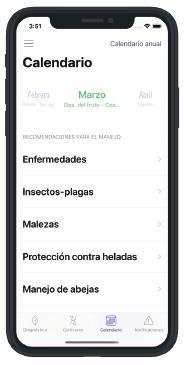
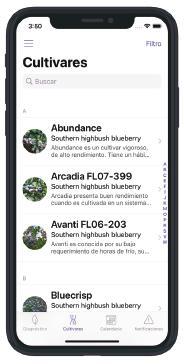
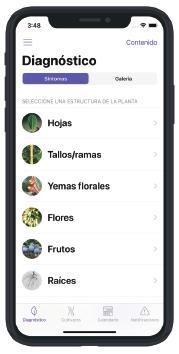
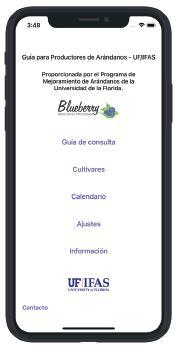

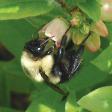
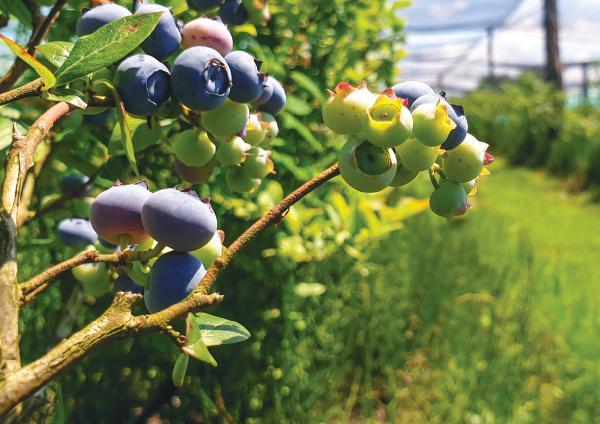
ASpanish language version of the UF/IFAS Blueberry Growers Guide app is scheduled to be released by this month. Users will be able to choose between English and Spanish when using the app, as well as selecting (long press) a Damage, Cultivar, or Calendar Management detail item to see an Englishto-Spanish or Spanish-to-English translation. All of the existing app modules, including the scouting guide, cultivars module, and monthly management calendar, will have all information available in Spanish.
Please let us know what you think of the new Spanish language version, and if you haven’t downloaded the app yet, please take a look and let us know what you think of the app overall.
iOS: https://apps.apple.com/us/ app/uf-blueberry-growersguide/id1535258711



Android: https://play.google.com/ store/apps/details?id=co. austn.ss.blueberry




FloridaBlueberryGrowers.org The Blueberry News | 15
app update _ _____
CREDIT
DOUG PHILLIPS, UF/IFAS Blueberry Extension Coordinator
topic of the season
continued from page 14
POSTHARVEST PLANTS, CONT.

CHILLI THRIPS
Chilli thrips are becoming a more pronounced problem in blueberry. Adults feed on blueberries in late spring to early summer shortly after the bushes are pruned. Chilli thrips feed primarily on young leaves, causing leaf bronzing and shoot dieback. During heavy infestation, the edges around younger leaves and stems are eaten and leaf curling occurs. The chilli thrips are smaller than the flower thrips and are approximately 0.04 inches long with dark fringed wings and dark spots across the back of the abdomen. Insecticides that can be used to manage chilli thrips include Delegate® (spinetoram), Assail® (acetamiprid), Sivanto® (flupyradifurone), and Apta® (tolfenpyrad). Conventional products that can be used to manage chilli thrips include Malathion and Sevin® (carbaryl). See Table 2 and EDIS publication ENY-2053, “Chilli Thrips on Blueberries in Florida” (https://edis.ifas.ufl. edu/publication/IN1298).
DIAPREPES (CITRUS ROOT WEEVIL)
See discussion above.
DIEBACK DISEASES OF SOUTHERN HIGHBUSH VARIETIES
Most southern highbush varieties are hedged immediately after harvest. Hedging cuts can serve as an entry point for many stem pathogens. At the end of each day of hedging, application of broad-spectrum fungicides such as Captan mixed with Prophyt® may help reduce infection. Resistance to azoxystrobin has been confirmed for Anthracnose stem dieback in central Florida. Do not use Abound® as a stand-alone application where resistance is known, but tank-mix with Captan or Bravo. See Table 1 and EDIS publication PP347, “Botryosphaeria Stem Blight on Southern Highbush Blueberry in Florida” (https://edis.ifas.ufl.edu/publication/PP347).
FLATHEADED BORERS
See discussion above.
FLEA BEETLES
The blueberry flea beetle can cause serious damage during the summer months. Blueberry flea beetle eggs, and possibly adults, overwinter in the leaf litter of blueberry fields. Eggs are very small and orange-yellow in color, and hatching coincides with leaf bud opening. Larvae migrate to the foliage and feed on blossoms and leaf margins, giving the leaves a notched appearance. The larval stage takes 9–20 days to complete. Fully-grown larvae fall to the soil and pupate, with adults emerging approximately 15–28 days later. Adults are less than 0.25 inches in length, oval shaped, and a shiny copper bronze or metallic blue in color, and they chew small holes in the foliage. Adults mate and lay up to 200 eggs per female. The blueberry flea beetle has several generations per year in the southern United States. See Table 2 and EDIS publication ENY-411, “Insect Management in Blueberries in the Eastern United States” (https://journals.flvc.org/edis/article/view/116379).

IMPORTED FIRE ANTS
See discussion above.
SPIDER MITES
The southern red mite is the key spider mite pest attacking blueberry plants in Florida. Southern red mites primarily infest the lower side of the leaf, giving the leaf a bronzing appearance when the population is high. Southern red mites also produce a protective web made of silk over the infested surface to protect them from predators. The underside of leaves should be closely examined with a 10x hand lens for adults, shed skins, and webbing. Tapping foliage onto a sheet of white paper can also be used to find adult mites. A few miticides, including fenazaquin (Magister®), fenpyroximate (Portal®) and acequinocyl (Kanemite®), have recently been labelled for spider mites. See Table 2 and EDIS publication ENY-1006, “Mite Pests of Southern Highbush Blueberry in Florida” (https://edis.ifas.ufl.edu/publication/IN1284).
WHITE GRUBS (GRUBS OF ASIATIC GARDEN BEETLE, EUROPEAN AND MASKED CHAFER, AND ORIENTAL BEETLE)
White grubs are the larval form of certain beetle species, such as the masked chafer. They feed on blueberry roots, and damaged plants have the appearance of drought stress. It may take a number of years for larvae numbers to increase to a damaging level, although feeding injury on young plants can quickly result in symptoms and plant death. Masked chafer larvae are up to one inch long, with whitish bodies and brown head and legs. See Table 2.
YELLOW-NECKED CATERPILLAR
Yellow-necked caterpillars feed on the foliage of blueberry plants. Their bodies are covered with long, fine whitish hairs. The head is black, the area behind the head is yellow, and the body is covered with fine white hairs. Feeding by newly hatched caterpillars can skeletonize the foliage, leaving only the large leaf veins. In significant infestations, plant defoliation can occur. This can be minimized by pruning out infested stems. See Table 2.
continued on page 18
16 | The Blueberry News FloridaBlueberryGrowers.org
The Wedgworth Way
Four years ago was not the right time for Brittany Lee to become president of the Florida Blueberry Growers Association. That is until Ryan Atwood convinced her that it’s always the right time to step up and lead.
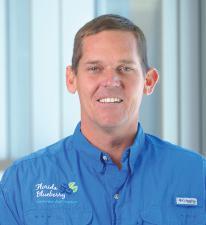

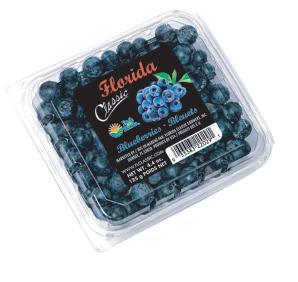
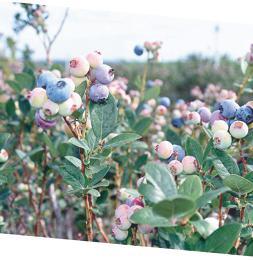
In addition to his work in support of the Florida blueberry industry, what made Atwood so persuasive was that he and Lee are alumni of the UF/IFAS Wedgworth Leadership Institute for Agriculture and Natural Resources. The two-year program is a series of multi-day seminars throughout the state examining complex issues in agriculture and natural resources.

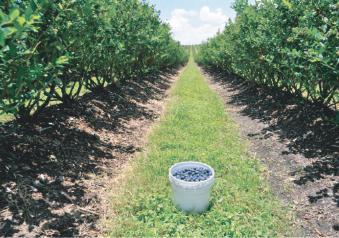
The experience makes classmates and fellow alumni lifelong associates and friends. The leadership development program emphasizes the responsibility of graduates to use their newly developed skills and influential network to seek opportunities to serve. Alumni such as Mike Joyner of the Florida Fruit and Vegetable Association are so devoted to the value of their experience that they speak of the importance of honoring the Wedgworth family name.
Lee had nominated Atwood for Wedgworth. He returned the favor by nominating her for FBGA president. Lee demurred. She’d just become a mother weeks before, and she was dealing with saving her crop from a freeze.
Atwood invoked the family name.
“That’s not very Wedgworth of you,” he told Lee. The rest is history. Lee served three years as your president and then became the association’s first and only executive director. Atwood succeeded her as president.
Wedgworth alumni include FBGA board member Kyle Straughn and grower Chuck Allison.
Wedgworth celebrates 30 years of programming this year, and Class XI graduates in July. Applications will open in late spring 2023. For more information about the program, contact Christy Chiarelli at ccw@ufl.edu.

Atwood had been interested in Wedgworth since his days as a UF/IFAS Extension agent because of the learning opportunity it represented.
No one had to push leadership on Atwood. He’s long been active in the association, he went through FFVA’s Emerging Leader Development Program, and he’s been active in his local Farm Bureau. Yet he believes he’s done even more because of his Wedgworth experience.
As Atwood puts it, “If you’re going to take a spot in the program, you have to step up.” He stepped up by joining the St. Johns River Water Management District board to represent agriculture. He also served on the U.S. Highbush Blueberry Council.

Leadership and service costs. Atwood could be busy with paid work during the many hours he spends volunteering on boards and councils. Wedgworth, too, took him away from his family and job.
But he found the program so valuable that he was willing to make yet another sacrifice. He nominated his business partner. Atwood is picking up any slack that results from Michael Hill being away with the current Wedgworth class.
And Atwood is already thinking ahead about early career H&A Farms employees as Wedgworth candidates. He’s thinking about them, about the industry, about Florida agriculture.
I can’t pay him a higher compliment for his service and sacrifice than this: That’s very Wedgworth of him.
FloridaBlueberryGrowers.org The Blueberry News | 17 Harvesting. Packing. Marketing. D UN D E E BER RY G R OWER S ASSOCI ATIO N Currently Accepting New Growers Our company is a wholly owned subsidiar y of Dundee Citrus Growers Association which has been in business since 1924. We are a vertically integrated company that offers harvesting, packing and marketing ser vices Our “Florida Classic” brand is a well-recognized and respected label throughout the United States and Canada. Our packing facility is conveniently located one mile East of Highway 27 in Dundee Contact Steven B. Callaham steven.callaham@dun-d com | 863.287.2636 111 1st Street Nor th, Dundee, FL 33838-1739 J. Scott Angle jangle@ufl.edu @IFAS_VP J. Scott Angle is the University of Florida’s Vice President for Agriculture and Natural Resources and leader of the UF Institute of Food and Agricultural Sciences (UF/IFAS).
BRITTANY LEE
RYAN ATWOOD
topic of the season
continued from page 16
TABLE 1. DISEASE MANAGEMENT OPTIONS, CONT.
Make applications after harvest on a monthly interval following bacterial canker use instructions. Ensure good cane coverage and canopy penetration. Do not mix with Aliette®, any phosphite fungicide, or any acidifying agents. Do not exceed 28 lb per acre per year. Copper products provide preventive management of algal stem blotch only. other copper products Many formulations and products that contain copper are labeled for use on blueberry at various rates and application intervals. Carefully follow all label instructions for any product to avoid phytotoxicity. Algal stem blotch is not likely to specifically appear on the label, but these products can be used as long as the crop and site is on the label.
Resistance to this fungicide in the ripe rot pathogen is common in central Florida. Use a Captan product in a tank mix where resistance is known. Subsequent applications can be made at 7-to-14-day intervals. Do not apply more than two sequential applications before switching to a fungicide with another mode of action (e.g., Switch®). Do not apply more than 1.44 qt per acre per season.
h 0 days
Applications can be made at 7-to- 10-day intervals when conditions warrant. Do not apply more than 56 oz of product per acre per year. Make no more than two sequential applications before using another fungicide with a different mode of action.
Pyraclostrobin + boscalid (Pristine®)
18.5–23 oz +++++ 12 h 0 days
Resistance to this fungicide in the ripe rot pathogen is common in central Florida. Use a Captan product in a tank mix where resistance is known. Do not mix Pristine® with anything other than Captan.

Ziram (Ziram 76DF) 3 lb ++ 48 h ~30 days Do not apply later than 3 weeks after full bloom.
Captan (Captan 50 WP)
5 lb +++ 48 h 0 days Do not apply more than 70 lb per acre per crop year.
Captan (Captan 4L®) 2 qt +++ 48 h 0 days Do not apply more than 35 qt per crop year.

Fluazinam (Omega® 500F) 1.25 pt ? 12 h 30 days
Do not use more than 7.5 pt per acre per season. Do not tank mix with an adjuvant.
Metconazole (Quash®) 2.5 oz ? 12 h 7 days Do not make more than three applications per acre per crop year. Alternate with a fungicide with another mode of action.
Prothioconazole (Proline® 480 SC)
5.7 fl oz ? 12 h 7 days Make up to 2 applications per year on a 7–10 day schedule. A tank mix with Captan is recommended for resistance management and to provide Botrytis suppression.
continued on page 22
18 | The Blueberry News FloridaBlueberryGrowers.org
Disease/ Pest Problem Management Options Amount of Formulation per Acre Effectiveness (Least = + to most = +++++) REI (restricted entry interval) PHI (postharvest interval) Comments
stem blotch Kocide® 3000 1.75–3.5 lb ++ 48 h 0 days
Algal
Anthracnose (ripe rot) and Alternaria rots Azoxystrobin (Abound®) 6.2–15.4 fl oz +++++ 4h 0 days
Cyprodinil
fludioxonil Switch ® 62.5 WG 11–14 oz +++++ 12
+


Our copper sulfate pentahydrate in-solution formula is Our copper sulfate pentahydrate in-solution formula is OMRI-listed OMRI-listed with systemic capabilities and has proven with systemic capabilities and has proven results combating disease in copper-resistant strains! results combating disease in copper-resistant strains! It’s environmentally friendly by using less than an 1/8 lb It’s environmentally friendly by using less than an 1/8 lb to 1/4 lb per acre of metallic copper specifically to 1/4 lb per acre of metallic copper specifically designed to combat agricultural disease for a variety of designed to combat agricultural disease for a variety of specialty fruits, vegetables, citrus and tree nuts! specialty fruits, vegetables, citrus and tree nuts!
Combat Algal Stem Blotch, Combat Algal Stem Blotch, Anthracnose, Bacterial Canker, Anthracnose, Bacterial Canker, Twig Blight and Fruit Rot! Twig Blight and Fruit Rot! www.MagnaBon.com (800) 845-1357
CS 2005 CS 2005
Spring and Early Summer Suggested Management Items





______ CREDIT
 by DOUG PHILLIPS, UF/IFAS Blueberry Extension Coordinator
by DOUG PHILLIPS, UF/IFAS Blueberry Extension Coordinator

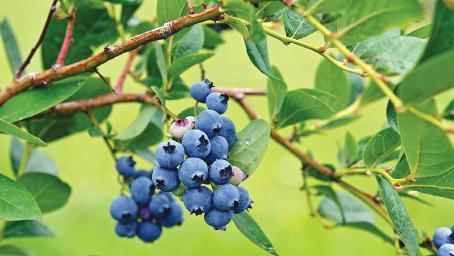
The tables below list suggested blueberry management items for spring and early summer months. Specific disease, insect, and weed controls are listed in the 2022 Florida Blueberry IPM Guide (https:// edis.ifas.ufl.edu/publication/HS380), as well as in subject-specific publications referenced below. Suggested management items for the entire calendar are available in the UF/IFAS Blueberry Growers Guide app and in an EDIS publication, Calendar for Southern Highbush Blueberry Management in Florida (https://edis.ifas.ufl.edu/publication/HS1363). A list of all UF EDIS blueberry publications can be found at www.blueberrybreeding.com/blog, along with a summary description and link to each.
APRIL
Disease
Apply suggested fungicides in rotation for control of anthracnose and/or Alternaria fruit rot; promptly harvest and cool ripe fruit. One tool growers may consider in timing spray applications is the Blueberry Advisory System (BAS) at www.agroclimate.org/BAS, which indicates when weather conditions are favorable for the development of anthracnose fruit rot.
Insect
Pests
Monitor for gall midge and flower thrips and control as needed. Spray suggested insecticides to control spotted wing drosophila (SWD), and promptly harvest ripe fruit. If living north of Lake City and there is a history of blueberry maggot, establish yellow sticky traps to monitor for blueberry maggot adults. Also, in infested areas, start scouting for adult Diaprepes (citrus) root weevils (by pulling out dead or dying plants and examining the roots and surrounding soil/bark), and adult flatheaded borers on the blueberry foliage. No pesticide is labeled in blueberry for citrus root weevil and flatheaded borer; however, some of the cover sprays for spotted wing drosophila will control these pests. See UF EDIS Publication ENY999, Diaprepes Root Weevil on Southern Highbush Blueberry in Florida (https://edis.ifas.ufl.edu/publication/IN1241).
Post-harvest, spray to control blueberry bud mite if present or observed in prior season.
Weeds Apply post-emergence herbicide if weeds are at densities that hinder bush growth. See UF EDIS Publication HS90, Weed Management in Blueberry (https://edis.ifas.ufl.edu/publication/wg016).
20 | The Blueberry News FloridaBlueberryGrowers.org
Disease
Monitor for post-harvest leaf diseases (rust, anthracnose, Septoria, target spot, Phyllosticta) and apply suggested control measures. See UF EDIS Publication PP348, Florida Blueberry Leaf Disease Guide (https:// edis.ifas.ufl.edu/publication/PP348).
Insect


Pests
Continue with insecticide sprays for spotted wing drosophila for the remaining ripe fruit that is left on the bush. Continue monitoring for blueberry maggot in affected areas. Continue monitoring for adult citrus root weevils (by pulling out dead or dying plants and examining the roots and surrounding soil/bark) and adult flatheaded borers in infested areas. Post-harvest, spray to control blueberry bud mite if present or observed in prior season. Scout for chilli thrips (leaf curling and bronzing) and blueberry flea (leaf) beetle (shot holes in the leaf) and apply suggested control measures if present. See UF EDIS Publication EENY2053, Chilli thrips on Blueberries in Florida (https://edis.ifas.ufl.edu/publication/IN1298).
Weeds Apply a pre-emergence herbicide after harvest (tank mix with a post-emergence herbicide if weeds are at densities that hinder bush growth).
Pruning
After harvest is complete, hedge back bushes to stimulate new vegetative growth, immediately spraying with a suggested fungicide to minimize the risk of fungal pathogens infecting through pruning wounds. See UF EDIS Publication HS1359, Pruning Southern Highbush Blueberry in Florida (https://edis.ifas.ufl.edu/ publication/HS1359).
JUNE
Disease






Scout for algal stem blotch. See UF EDIS Publication PP344, Algal Stem Blotch in Southern Highbush Blueberry in Florida (https://edis.ifas.ufl.edu/publication/ PP344). Selectively prune out canes infected with algal stem blotch, Botryosphaeria stem blight, and dead canes. See UF EDIS Publication PP347, Botryosphaeria Stem Blight on Southern Highbush Blueberry in Florida (https://edis.ifas.ufl.edu/ publication/PP347). Monitor and manage leaf diseases. See UF EDIS Publication PP348, Florida Blueberry Leaf Disease Guide (https://edis.ifas.ufl.edu/publication/ PP348). Apply Ridomil to help prevent Phytophthora root rot. On farms managing bacterial wilt, begin monthly through-irrigation or banded bed applications of a phosphorous acid product. See UF EDIS Publication PP332, Bacterial Wilt of Southern Highbush Blueberry Caused by Ralstonia solanacearum (https://edis.ifas. ufl.edu/publication/PP332).
Insect Pests Scout for flea beetles, larval citrus root weevil (by pulling out dead or dying plants and examining the roots and surrounding soil/bark), larval flatheaded borer, chilli thrips, and southern red mites and apply suggested control measures if present. See UF EDIS Publication ENY1006, Mite Pests of Southern Highbush Blueberry in Florida (https://edis.ifas.ufl.edu/publication/IN1284).
Leaf
Tissue Samples
Leaves should be collected for tissue nutrient analysis. Select samples from fully expanded leaves in the middle of a recent summer growth flush.
Weeds Apply post-emergence herbicide if weeds are at densities that hinder bush growth.
FloridaBlueberryGrowers.org The Blueberry News | 21
MAY
topic of the season
continued from page 18
TABLE 1. DISEASE MANAGEMENT OPTIONS, CONT.
Do not apply more than 54.7 fl oz per acre per year. Rotate to a different fungicide group after no more than 2 applications. Reapplication interval is 7 to 14 days. Only Luna Tranquility is labeled by supplemental label for blueberry in Florida.
Subsequent applications can be made at 14-day intervals. Consider tank mixing with Captan or Bravo. When hedging is conducted immediately following harvest, this is a good time to consider an application. Do not exceed 1.44 qt per acre per season. Do not apply more than two sequential applications of Abound® before switching to a fungicide with another mode of action.
No more than two sequential applications of Pristine® should be made before alternating with fungicides that have a different mode of action. Do not apply more than four applications of Pristine® per acre per crop year. Fenbuconazole
oz ++++ 12 h 0 days
oz +++ 12 h 30 days
Do not make more than four applications or apply more than 8 oz of Indar® 75 WSP (0.38 lb active) per acre per year. Indar® 75 WSP belongs to the sterol demethylation inhibitor (DMI) class of fungicides. Alternation with fungicides of different classes is recommended.
Metconazole (Quash®) 2.5 oz +++ 12 h 7 days Do not make more than three applications per acre per crop year. Alternate with a fungicide with another mode of action. Propiconazole ( Tilt®)
6.0 fl oz +++ 24 h 30 days Tilt®, another DMI fungicide, may be applied by ground or aerial application (see label). Do not apply more than 30 fl oz per acre per season. Tilt® is more effective when it dries ahead of a rain.
Prothioconazole (Proline® 480 SC)
Chlorothalonil (Bravo Weather Stik®)
Cyprodinil + fludioxonil (Switch® 62.5WG)
Fluopyram + pyrimethanil (Luna Tranquility®)
5.7 fl oz ++++ 12 h 7 days Make up to 2 applications per year on a 7–10 day schedule.
3–4 pt ++++ 12 h (with restrictions) 6.5 days (w/o)
42 days Apply only as a postharvest fungicide for Septoria and rust. Do not combine with other pesticides, surfactants, or fertilizers.
11–14 oz +++ 12 h 0 days
Applications can be made at 7-to- 10-day intervals when conditions warrant. Do not apply more than 56 oz of product per acre per year. Make no more than two sequential applications before using another fungicide with a different mode of action.
16–27 fl oz ? 12 h 0 days
Do not apply more than 54.7 fl oz per acre per year. Rotate to a different fungicide group after no more than 2 applications. Reapplication interval is 7 to 14 days. No efficacy data for this product are available for blueberry in Florida. Only Luna Tranquility is labeled for blueberry in Florida.

continued on page 24

22 | The Blueberry News FloridaBlueberryGrowers.org
Disease/ Pest Problem Management Options Amount of Formulation per Acre Effectiveness (Least = + to most = +++++) REI (restricted entry interval) PHI (postharvest interval) Comments Anthracnose (ripe rot) and Alternaria rots Fluopyram + pyrimethanil (Luna Tranquility®) 13.6–27 fl oz ? 12 h 0 days
Anthracnose, septoria, target spot, and rust leaf diseases Azoxystrobin (Abound®) 6.2–15.4 fl oz ++++ 4h 0 days
Pyraclostrobin + boscalid (Pristine®) 18.5–23
(Indar® 2F) 2.0


FloridaBlueberryGrowers.org 23
topic of the season
continued from page 22
TABLE 1. DISEASE MANAGEMENT OPTIONS, CONT.
For bacterial wilt, the product must be soil-applied. Follow label instructions for chemigation or directed soil application with light irrigation. Reapplication interval is 3 to 28 days. Make applications postharvest through end of summer.
0 days Apply immediately after postharvest hedging.
h 12 h Apply Aliette® as a foliar spray for Phytophthora and Pythium root rots and Septoria leaf spot. Subsequent applications can be made at 14-to-21-day intervals. Two or three fungicide applications following harvest are generally sufficient to prevent major outbreaks of Septoria leaf spot. Assuming that hedging is conducted immediately following harvest, this is a good time to consider an application. Do not exceed four applications per acre per year.
Do not tank mix with copper and foliar fertilizers and do not apply in acidic water or add acidifying agents, because these practices could damage fruit or foliage. When tank-mixing this product with others, test the mix on a small area to make sure that phytotoxicity does not occur.


3.6 pt ++++ 48 h 0 days
Established plantings: Apply 1/4 pt/1000 linear feet of row (3.6 pt per acre broadcast basis) in a 3-foot band over the row. One application prior to bloom and one additional application postharvest, approximately 6 months later. New plantings: Apply 3.6 pt per acre (broadcast rate) at or after planting. An 18-inch band over the row is recommended. Do not apply more than 0.9 gal per acre broadcast during the 12 months before plants bear harvestable fruit, or illegal residues may result. For both new and established plantings, one additional application may be made to coincide with periods most favorable for root rot development.
4 pt ++++ 4h 0 days Apply as a foliar spray for Phytophthora and Pythium. Also effective against Septoria and anthracnose leaf spots. Do not tank mix with copper and foliar fertilizers and do not apply in acidic water or add acidifying agents, because these practices could damage fruit or foliage. When tank-mixing this product with others, test the mix on a small area to make sure that phytotoxicity does not occur.
continued on page 26
24 | The Blueberry News FloridaBlueberryGrowers.org
Disease/ Pest Problem Management Options Amount of Formulation per Acre Effectiveness (Least = + to most = +++++) REI (restricted entry interval) PHI (postharvest interval) Comments Bacterial wilt Phosphorous acid soil application (K-Phite) 2-4 qt +++ 4h
0 days
Dieback diseases (posthedging) Captan mixed with a phosphorous acid product (Captan 50WP + Prophyt® 5lb + 4 pt +++ 48
Phytophthora root rot Fosetyl-Al (Aliette® WDG) 5 lb +++
h
12
Mefenoxam (Ridomil Gold® SL)
Potassium phosphite (Prophyt®)
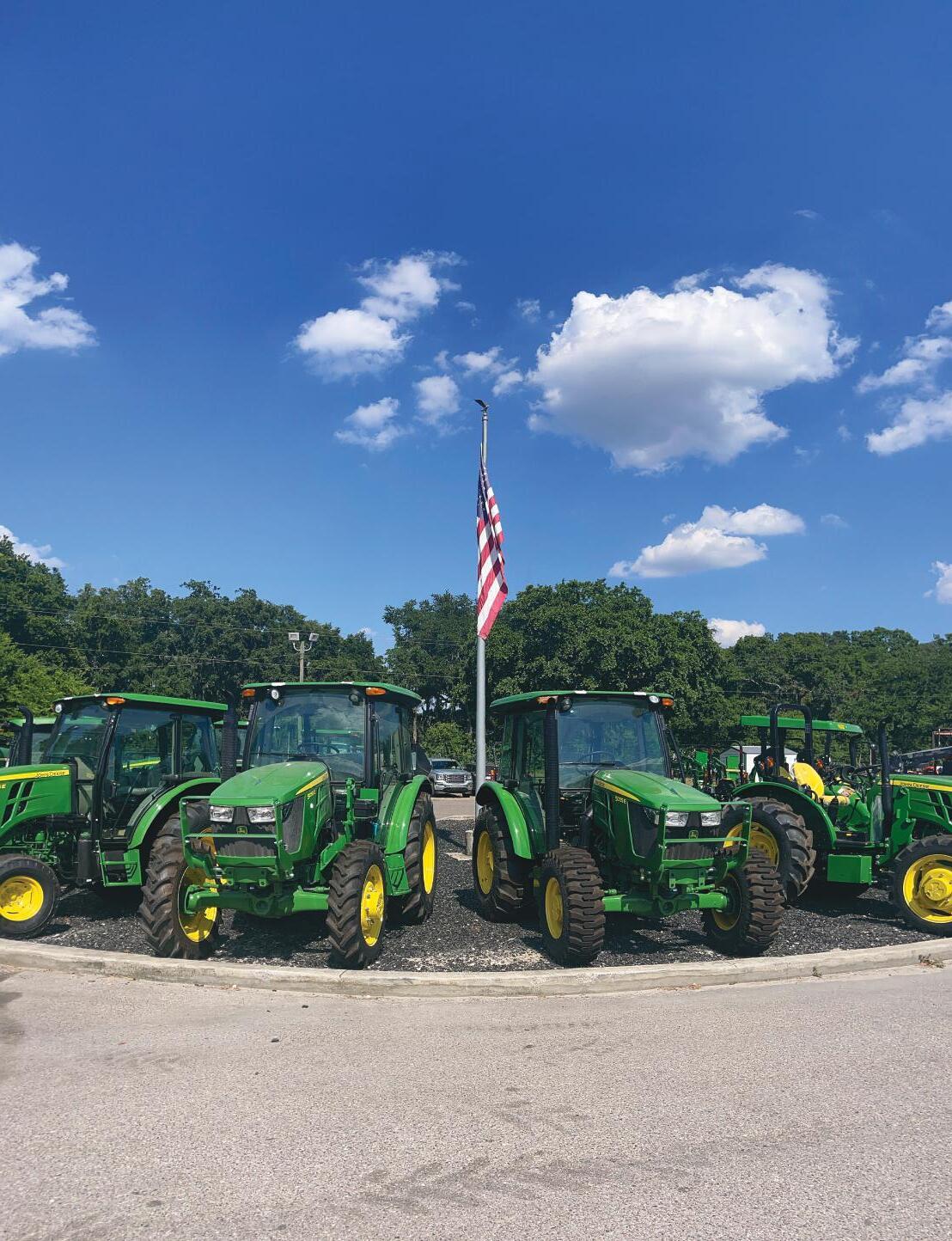

WE ARE HERE FOR YOU with 18 locations in Florida and always online at www. EFE1963.com
topic of the season
continued from page 24
TABLE 1. DISEASE MANAGEMENT OPTIONS, CONT.
Apply as a soil drench, as a soil-directed spray, or through irrigation system in spring before plants begin to grow, with a follow-up application postharvest prior to the rainy season.
Apply as a soil drench, as a soil-directed spray, or through irrigation system in spring before plants begin to grow, with a follow-up application postharvest prior to the rainy season.
TABLE 2. INSECT AND MITE PEST MANAGEMENT OPTIONS
DiPel® is an effective microbial insecticide. However, it should be applied to small, early-stage caterpillars.
Confirm® is very effective if applied to small, early-stage caterpillars.
Esfenvalerate should be used as a salvage treatment for large caterpillars. It is very effective, but if used often it encourages scale and mite buildup.
Some users may be allergic to Adjourn®; discontinue use if skin or eyes become inflamed.
days Apply in at least 50 gallons of water per acre. Use higher rates for heavier mite pressure. Do not make more than one application per year. Fenpyroximate
+++ 12 h 1 day Growers can make two applications per year.
Horticultural oil (JMS Stylet-Oil®) 3–6 qt/100 gal ++ 4h 0 days Blueberry bud mite cannot be readily seen, and by the time symptoms are observed in the spring, the mites are too deep for effective treatment. Avoid using this product if the temperature is above 85°F.
Horticultural oil (Stoller Golden Pest Spray Oil) 2 gal (low volume) application or 2 gal/100 gal (dilute spray)
Blueberry maggot

++ 4h 0 days Avoid using this product if the temperature is above 85°F.
Phosmet (Imidan® 70W ) 1.3 lb ++++ 24 h 3 days Imidan® is the material of choice for managing BBM. BBM sprays should protect berries from the start of oviposition until the last berries are harvested. Imidan® provides 10–14 days residual control. Do not apply more than twice per season.
Carbaryl (Sevin® 4F) 1.9–2.5 lb +++ 12 h 7 days BBM sprays should protect berries from the start of oviposition until the last berries are harvested. Sevin® provides 5–7 days of residual effectiveness.
continued on page 34

26 | The Blueberry News FloridaBlueberryGrowers.org
Disease/ Pest Problem Management Options Amount of Formulation per Acre Effectiveness (Least = + to most = +++++) REI (restricted entry interval) PHI (postharvest interval) Comments Phytophthora root rot Oxythiopiprolin (Orondis® Gold 200) 4.8 to 9.6 fl oz ? 4h 1 day
Oxythiopiprolin, Mefenoxam (Orondis® Gold) 28 to 55 fl oz ? 48 h 1 day
Disease/ Pest Problem Management Options Amount of Formulation per Acre Effectiveness (Least = + to most = +++++) REI (restricted entry interval) PHI (postharvest interval) Comments Azalea caterpillar Bacillus thuringiensis [BT] (DiPel® DF) 0.5–1.0 lb ++ 4h 0 days
Tebufenozide (Confirm® 2F) 4–8 fl oz ++++ 4h 14 days
Esfenvalerate (Asana® 0.66 EC) 4.8–16 oz ++++ 12 h 14 days
Esfenvalerate (Adjourn® 0.66 EC) 4.8–9.6 fl oz ++++ 12 h
14 days
Blueberry bud mite Fenazaquin (Magister® SC) 24–36 fl oz +++ 12 h 7
2 pt
(Portal®)
NELSON KIRKLAND, Publisher
The Pursuit Of Knowledge
FIELD DAYS IN AGRICULTURE are essentially showand-tell for adults, and they are every bit as exciting as it was when I was a kid. Don’t get me wrong, the advanced principles, techniques, and subject matter are far from child’s play, but the principles remain the same: Share, learn, and grow.
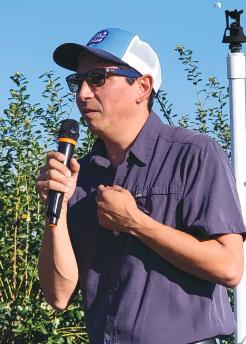

I recently attended the Florida Blueberry Growers Association field day at Jason Carlton's farm in Arcadia, where I was able to see firsthand how the evergreen operation was yielding excellent results among several varieties. I also got to travel to Leonard Park’s Frogmore Fresh farm in Dade City to see new varieties set up for machine harvesting.
Field days are just one way to educate growers and other agricultural professionals about the latest techniques and advancements. The spirit of collaboration, knowledge, and innovation thrives when we get to experience what others are doing.
The Florida Blueberry Growers Association, along with the U.S. Highbush Blueberry Council and the folks from UF/IFAS, have long extolled the values of field days, and for good reason: The information enhances each and every grower in attendance, who then, in turn, passes what they just learned along to someone else. Are you noticing a pattern? We must never stop learning.

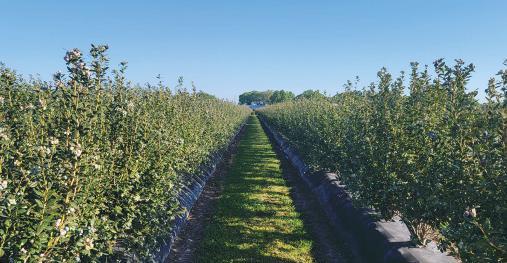

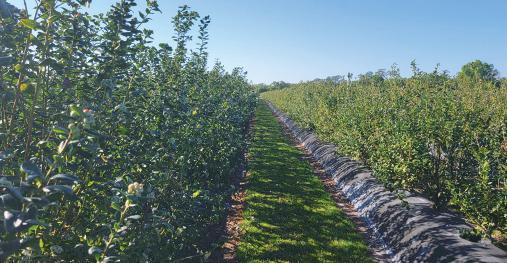

If we can tear ourselves away from our own farms and research, even just for a day, the payoff will make it worth our while.
Thank you to the FBGA and the folks from UF, who worked to make the Spring 2022 Field Day such a success for all involved. These photos are just a sampling of everything I saw at the Field Day.
FloridaBlueberryGrowers.org The Blueberry News | 27
interlude publisher, s
DOUG PHILLIPS PATRICIO MUÑOZ
VARIETY AVANTI
VARIETY CHICKADEE
VARIETY ENDURA
Top Threat Tips to Help Mitigate Damage From Chilli Thrips
Chilli thrips are a significant pest on southern highbush blueberries in Florida with the potential to cause heavy foliage damage from late spring through early fall. Although there are insecticides with efficacy on chilli thrips, the numbers of applications used and cost of products have become a significant management issue for Florida growers.
“Chilli thrips have emerged as the number one pest threat at Frogmore Fresh,” says Leonard Park, president of the Florida Blueberry Growers Association and farm manager at Frogmore Fresh.
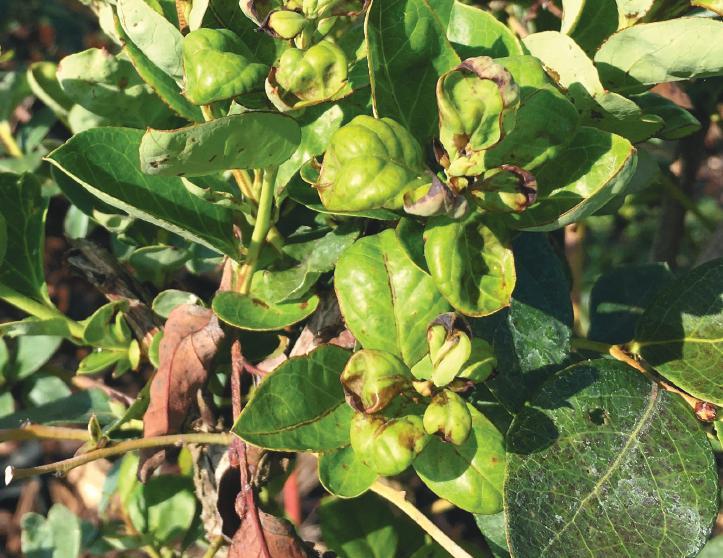
“We start seeing them in spring as soon as young suckers flush and they crank up before we finish harvest in May. Once we hedge, they explode in June if we haven’t already geared up our protection program. We continue fighting them into September, always diligent to scout and respond. Suppression seems the best we can achieve. Some go-to chemicals like Delegate are now losing effectiveness, so we have tried numerous alternatives with no satisfactory solution. As the most costly pest for our farm, we hope our UF experts and the crop protection industry can find new and better options.” The following is a discussion of this insect pest, along with management suggestions and the results of recent insecticide field trials.
Chilli thrips, (Scirtothrips dorsalis Hood), were first observed in Florida in 1991 and again in 1994, with the
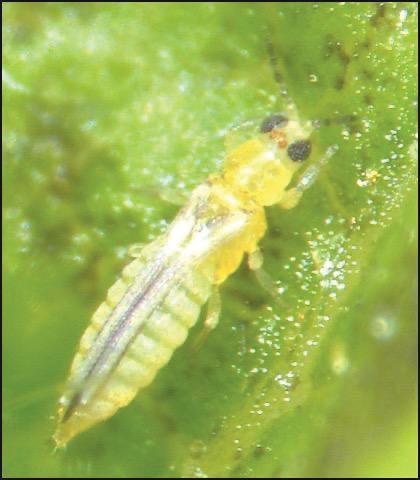
first established population reported in October 2005 on roses in Palm Beach County. It was first recorded in blueberries in Hernando, Pasco, and Sumter counties in July 2008. Chilli thrips typically appear during the new flush of foliage growth following post-harvest hedging in late spring to early summer, and prefer feeding on young, tender foliage.
Life Cycle
Adult chilli thrips are only 1-2 mm (<1/16 inch) in length, smaller than flower thrips, with pale yellow bodies, dark fringed wings, and dark brown incomplete abdominal stripes (Figure 1). The lifecycle of chilli thrips (i.e., egg, larva, pupa, and adult) is short and typically lasts about 18-20 days in favorable environmental conditions. Adult females lay about 60 eggs in their lifetime. Eggs usually hatch in 5-8 days, depending on environmental conditions. There are two larval stages that take approximately 8-10 days to develop, during which they are actively feeding. Pupal stages last for 2-4 days when no feeding occurs. Adults emerging from the pupal stages typically live for 20-25 days.
Plant Injury
Chilli thrips feeding can cause substantial damage to blueberry foliage. Adults and larvae punch holes through epidermis cells and remove the cellular contents of leaf and stem tissues, leading to tissue necrosis and death. Injury symptoms first appear as bronzing along leaf veins and petioles, and leaves gradually begin to curl and distort (Figure 2). Heavy infestations can cause leaf defoliation with extensive curling of leaves, reducing
28 | The Blueberry News FloridaBlueberryGrowers.org bug of the month
Figure 1. Adult chilli thrips. Photo by B. Panthi, UF
Figure 2. Chilli thrips feeding injury. Photo by B. Panthi, UF
Table 1. Registered products for managing chilli thrips in Florida blueberries.
IRAC code1 Chemical group Active ingredients Registered products


1B Organophosphates
3A Pyrethroids
Malathion
Diazinon
Pyrethrins
Fenpropathrin
Bifenthrin
Malathion 57EC
Diazinon 50W, AG600 WBC
PyGanic EC 5.0, Azera
Danitol 2.4 EC
Brigade WSB
4A Neonicotinoids Acetamiprid Assail 70WP
4D Butenolides Flupyradifurone Sivanto 200 SL, Prime
5 Spinosyns Spinetoram
Delegate WG
Spinosad Entrust (for organic use)
15 Benzoylureas Novaluron Rimon
28 Diamides Cyantraniliprole Exirel
UN - Azadiractin
UN - Beauvaria bassiana strain GHA
UN - Chromobacterium subtsugae strain PRAA4-1
UN - Metarhizium anisopliae strain F52v
UN - Isaria fumosoroseus Apopka strain 97
Aza-Direct, Neemix 4.5% EC
BotaniGard ES, Mycotrol ESO
Grandevo
MET52 EC
PFR-97 20%WDG*
1Insecticide Resistance Action Committee (IRAC) Mode of Action Classification v. 8.2 March 2017. Source (Vegetable Production Handbook of Florida, 2017-18).
photosynthesis and possibly impacting floral bud initiation in cases of significant defoliation. During high infestations chilli thrips may also feed on fruit, causing a mottled appearance.
Monitoring to ensure early detection is important for effective chilli thrips control. Scouting for adults can be performed by observing young leaves with a hand lens (20X), tapping young foliage onto a white sheet of paper or phone screen, or using white or yellow sticky cards.
Chilli thrips can have an irregular distribution within a field with areas of hot spots, so sufficient samples should be collected to provide an accurate estimate of any population in the field. The appearance of bronzing on new flush may be the first indication of the chilli thrips presence in blueberry fields, although at that point there may be significant populations already present.
An integrated pest management (IPM) plan for chilli thrips control includes cultural, biological, and insecticide controls. Cultural control involves the elimination of weeds and other host plants in and around production fields that can support chilli thrips growth
and development. Biological controls include beneficial predators such as Orius insidiosus (minute pirate bug), which feeds on all life stages of thrips, as well as Amblyseius swirskii (predatory mites) and Geocoris spp. (big-eyed bugs), which have shown some effectiveness in controlling chilli thrips.
Application of insecticides is the primary method of managing chilli thrips in blueberry. These include spinetoram (Delegate®), tolfenpyrad (Apta®), novaluron (Rimon®), acetamiprid (Assail®), and flupyradifurone (Sivanto®). Spinosad (Entrust®) can be used in organic production. In a recent field trial, spinetoram and tolfenpyrad were the most effective of the insecticides evaluated. Spinetoram has systemic activity, allowing the chemical to be absorbed into plant tissues relatively quickly. Spinetoram has been shown to be effective in controlling all of the life stages of chilli thrips, including egg when mixed with novaluron, an insect growth regulator which affects egg development. The University of Florida plans to conduct additional field trials this summer, and several new products will be evaluated. A list of products registered for managing
chilli thrips in Florida blueberries along with their active ingredients and insecticide classes are provided in Table 1. Be sure to follow all insecticide label instructions.
For additional details see UF EDIS Publications ENY-2053, Chilli Thrips on Blueberries in Florida (https://edis.ifas.ufl. edu/pdf/IN/IN129800.pdf) and HS1156, 2022 Florida Blueberry Integrated Pest Management Guide https://edis.ifas.ufl. edu/publication/HS380
DR. OSCAR LIBURD, Professor and Program Leader, Fruit and Vegetable Entomology, UF & DOUG PHILLIPS, UF/IFAS Blueberry Extension Coordinator
FloridaBlueberryGrowers.org The Blueberry News | 29
_________ CREDIT
grower's thoughts
Post-Harvest Primer Summer Fungal Leaf Disease Management
It’s complicated. Growers have many tools from which to choose when orchestrating their post-harvest plan to keep bushes healthy. These can range from horticultural inputs to selecting which and when to apply numerous fungicide product options. With blueberries in Florida, most consider the season to start at post-harvest hedging and end the following calendar year with a successful harvest of fruit. Hedging (pruning away the old canes) resets the plants to produce a flush of young canes and new leaves. Leaves hang around until winter in deciduous production, and through the next harvest in evergreen. That’s a long time to keep leaves healthy. When things go wrong and bushes are severely defoliated prior to these times, flower bud initiation and carbohydrate storage (sugars used by the plant to push the blossoms, fruit, and new growth) suffers, reducing the harvest. The flip side is that management tools cost money and without knowing the return on investment, how clean can you afford to grow? The answer depends on many factors from the price you see during your harvest, the varieties in your fields, to how many tropical weather systems buzz overhead each summer. As a grower once told me … I know keeping leaves healthy is important, but they don’t eat (or sell) too good!
In general, summer in Florida brings hot and humid weather, along with increased rainfall and ideal conditions for the development of summer fungal
leaf diseases. There are several of these diseases that develop symptoms that can look similar and even occur on the same leaves. This article will discuss the different types of fungal leaf diseases we typically see in Florida, including a discussion of symptoms and some management suggestions. Additional information can be found in the UF/IFAS Blueberry Growers Guide app, and EDIS Publication PP348, Florida Blueberry Leaf Disease Guide (https://edis.ifas.ufl.edu/ publication/PP348).
Anthracnose Leaf Spot
Anthracnose leaf spot is caused by Colletotrichum gloeosporioides and can result in premature defoliation, poor floral bud development, and subsequent loss of yield. Symptoms are irregularly shaped lesions at the leaf edges, expanding from 1/4 inch to greater than 3/4 inch in diameter. The lesions have necrotic centers ranging from brown to dark brown, with distinct concentric circles (bull’s-eye patterns) occasionally visible (Figure 1). The fungus overwinters in infected leaves and stems from the previous season. In spring, when the weather gets warmer and more humid, the fungus produces spores that are spread by splashing water (rain or overhead irrigation), workers, and equipment. These spores will germinate and initiate new infection cycles. Anthracnose leaf disease is common after harvest in Florida and persists
through summer. In evergreen systems, this disease can be present on foliage throughout the winter months and harvest and can provide a source of inoculum for anthracnose fruit rot. Blueberry cultivars differ in their susceptibility; “Jewel” is considered very susceptible.
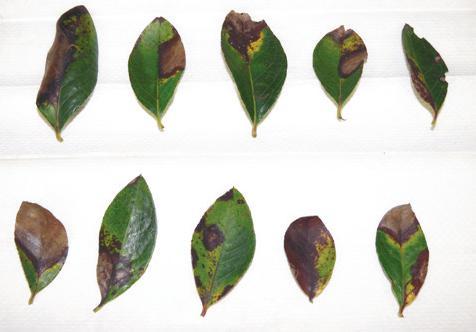
Management
Many registered fungicides are labeled for anthracnose on blueberry in Florida, and applications work best before symptoms become significant. On susceptible cultivars, applications should begin after post-harvest pruning, with reapplications according to label instructions through September in the deciduous production system. Demethylation inhibitor (DMI) fungicides (FRAC 3) such as IndarTM, OrbitTM, QuashTM, Quilt XcelTM, and ProlineTM are options to be used in rotation or in tank mixtures with compatible products from another group to help prevent fungicide resistance. Fungicides with different modes of action such as Luna TranquilityTM (FRAC 7 & 9), AboundTM (FRAC 11), PristineTM (FRAC 11 & 7), SwitchTM (FRAC 9 & 12), and captan (FRAC M4) are suitable for rotation with DMI fungicides. Single applications of BravoTM (FRAC M5) are also recommended after harvest. Anthracnose resistance to AboundTM and other FRAC group 11 fungicides has been confirmed in Central Florida, so these should be used in a premix product with two active ingredients or tank-mixed with another fungicide like captan to

30 | The Blueberry News FloridaBlueberryGrowers.org
Figure 1. Anthracnose leaf spot symptoms. Photos by P. Harmon, UF
ensure efficacy. Fungicides with monoand dipotassium salts of phosphorous acid have systemic action and include Agri-FosTM, K-PhiteTM, and ProPhytTM (potassium phosphite). These “phites” have shown some effectiveness against anthracnose. In evergreen systems, fungicide applications should continue from late fall through harvest, within applicable label limitations and rules.
Phyllosticta
Phyllosticta leaf spot is caused by Phyllosticta vaccinii, and is more commonly observed later in the summer (August–September) than anthracnose. Symptoms are brown leaf spots with irregular borders. Lesions range from small (less than 1/4 inch) to larger than one inch prior to causing defoliation. Lesions typically are surrounded by a dark brown to purple margin. A distinguishing feature of this disease is the presence of tiny black fungal pimples (pycnidia, the reproductive structures) that develop within the lesions (Figure 2). However, other fungi, including some that do not cause disease, can also produce small black structures on dead or decaying leaves. This disease is common in Florida, but it is considered to be of minor importance.
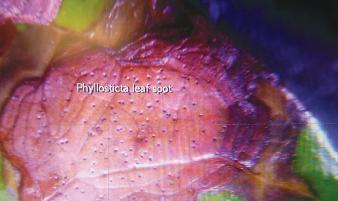
Management
There are no published fungicide recommendations for Phyllosticta leaf spot management on blueberry in Florida; however, in other crops (e.g., cranberry and maple), related diseases are managed with applications of the contact fungicide BravoTM (FRAC M5). General maintenance applications of contact fungicides like BravoTM or captan are recommended after harvest as needed or approximately every two weeks (for up to 6 weeks).


Rust
In Florida, this disease is caused by Naohidemyces vaccinii. Infected bushes can show premature defoliation, a decrease in floral bud differentiation, and reduced
yield. Different levels of susceptibility to this disease can be found in southern highbush blueberry (SHB). Symptoms are typically first observed on the upper leaf surface and begin as small, somewhat angular yellow spots that turn reddishbrown to black over time. Multiple blackto-red lesions can occur on the same leaf, ultimately turning the leaves yellow and red (Figure 3) before causing defoliation. Brightly colored yellow to orange spores are produced on the underside of the leaf, opposite the lesions on the upper leaf surface, and are key to distinguishing this disease from other leaf spots (Figure 4).
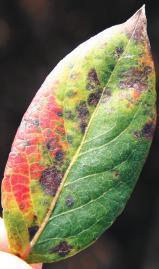
Rust spores are spread efficiently by wind. New leaf infections can begin in spring during or just after harvest, and disease activity increases again in early fall. In evergreen production the pathogen can persist throughout winter and harvest, causing fruit infections and defoliation which limits plant photosynthesis to support fruit development.
Management
Applications of fungicides are the best method of control. Systemic fungicides can move into the infected leaves and potentially stop rust development. However, most products will only reduce or delay the amount of sporulation because fungicides do not effectively kill the fungus inside the leaf. Fungicides do a better job of protecting against new infections, so making repeated applications to maintain a protective residue on the leaves is key to preventing the disease. Fungicides such as OrbitTM, IndarTM, QuashTM, ProlineTM (FRAC 3), PristineTM (FRAC 11 & 7) and BravoTM (FRAC M5) are effective against rust. Applications should begin after harvest and continue through late October on susceptible cultivars. In evergreen systems, fungicide applications should continue from late fall
through harvest, within applicable label limitations and instructions. Fungicides with different modes of action should be used in rotation or in a tank mix and as part of an integrated post-harvest foliage management strategy.
Septoria
Septoria leaf spot is caused by Septoria albopunctata. Severe infections can decrease yield due to defoliation, reduced levels of photosynthesis, and reduced flower bud initiation. Septoria spots are numerous but small (about 1/8 inch) and nearly circular, with light-brown to gray centers and broad purplish margins (Figure 5). These lesions can coalesce into larger necrotic areas prior to defoliation. Symptoms are generally more severe on older leaves that are closer to the ground. The disease typically occurs from mid to late harvest through June and may reappear during mild wet periods in fall. The pathogen can overwinter in infected or dead leaves and stems, or on other plant hosts, with spore germination and infection favored by mild wet weather (75°F–82°F). Early lesions serve as an inoculum source for further disease development, with spores spread by water splash (rain and overhead irrigation).
Management
Applications of protective and systemic fungicides with different modes of action help to reduce Septoria leaf spot severity. Fungicides of FRAC group 3, such as OrbitTM, IndarTM, QuashTM, Quilt XcelTM and Proline, and fungicides of other FRAC groups, such as Luna Tranquility (FRAC 7 & 9), AboundTM (FRAC 11), SwitchTM (FRAC 9 & 12), PristineTM (FRAC 11 & 7), and BravoTM (FRAC M5), are effective against this disease. Systemic phosphite fungicides such as Agri-FosTM, ProPhytTM and similar phosphonate products are also effective against Septoria; however, they must be applied after harvest to avoid possible fruit damage.
continued on page 32
FloridaBlueberryGrowers.org The Blueberry News | 31
Figure 2. Phyllosticta leaf spot symptoms
Figure 5. Septoria leaf spot symptoms
Figure 3. Rust symptoms on leaf top Figure 4. Rust spores on leaf underside
Target Spot
Target spot is caused by Corynespora cassiicola, first reported in blueberry in the US in 2014. More recently it has become a significant disease for Florida growers with significant defoliation observed on many SHB cultivars. Typical symptoms are 1/3- to 3/8-inch angular to irregular reddish-brown lesions with colors varying in concentric rings, resulting in a “target” or bull’s-eye pattern (Figures 6 and 7). Symptoms can be similar to the early symptoms of anthracnose leaf spot, and both diseases can occur simultaneously in susceptible varieties. However, target spot lesions tend to remain smaller, whereas anthracnose leaf spots can increase to larger than 1/2 inch in diameter. Fewer target
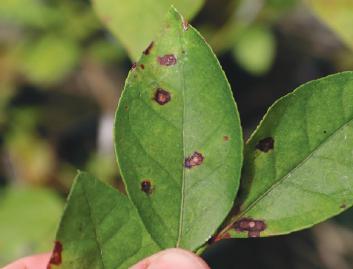
Pine Bark For

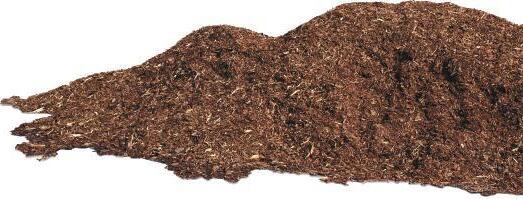
spot lesions are required before defoliation begins compared to anthracnose. Environmental conditions such as humid weather, warm temperatures (79°F–84°F), and moderate rainfall favor abundant fungal sporulation and rapid disease development. In the field, spores can be spread by wind or water splash (rain or irrigation).
Management
Growers have reported difficulty managing target spot once symptoms are observed and become significant. Preventive fungicide applications where the disease is known to occur and/ or careful scouting for the first disease symptoms are encouraged. Limiting periods of leaf wetness and high humidity within the plant canopy may also help reduce disease severity, accomplished by avoiding overhead irrigation, maintenance pruning to open canopies, and managing weeds in beds and row middles to increase airflow. No fungicide resistance is known at this time, and most fungicides that are used to manage anthracnose and rust should be effective against target spot. Growers should ensure good, even coverage with spray equipment to increase the efficacy of the fungicides applied.
In summary, these leaf diseases include some of the most common and problematic to occur on southern highbush blueberry in Florida, but there are others less frequently encountered. Growers are encouraged to submit a sample to a UF/ IFAS Plant Diagnostic Lab to determine what diseases may be active on their foliage during particularly difficult outbreaks or if symptoms do not match those pictured in extension resources. In planning a fungicide schedule or program, growers will note that several fungicide products are listed above that can help manage multiple diseases in the post-harvest period. In addition to those listed above, applications of fungicides that contain various forms of copper have some efficacy on these leaf diseases when applied during the summer for the management of algal stem blotch. Some copper fungicides are also approved for organic production and represent the most consistent performers for reducing disease pressure for organic growers. Current ongoing research is also evaluating some plant-derived oil products that are available for organic producers for their potential efficacy as well.
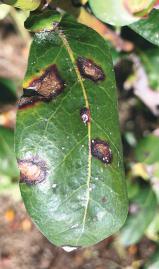
For conventional growers, the multisite contact fungicide Bravo (which cannot be used preharvest) is excellent for preventative applications during the post-harvest time frame to supplement the copper schedule or at the first symptoms of breakthrough leaf diseases, particularly on varieties or farms that have suffered from them in past seasons. More expensive, but potentially more effective, systemic fungicides can be applied at the same time (tank mix) or as alternatives to Bravo where unacceptable results occur otherwise. Be mindful of seasonal limits on the max number of applications that can be made and consider preserving products like Switch for those important bloom-through-harvest applications that can help us prevent fruit rots. In the end, growers have tough decisions to make regarding post-harvest leaf disease management each year, with their experiences from previous years informing estimations of risk and weighing potential returns on the investments of the many options available.
CREDIT by PHILIP HARMON, Professor, Plant Pathology, UF & DOUG PHILLIPS, UF/IFAS Blueberry Extension Coordinator
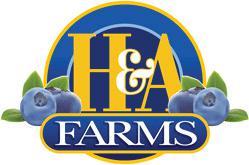
32 | The Blueberry News FloridaBlueberryGrowers.org
______
Grower's Thoughts, cont. from page 31
Figure 6. Target spot symptoms
Figure 7. Target spot symptoms
Sale Blueberry Growers Only Call Diego X. Vargas at 407-625-6436 or email diego.vargas@handafarms.com
To place a classified ad please e-mail info@centralfloridamediagroup.com or call (863) 248-7537.

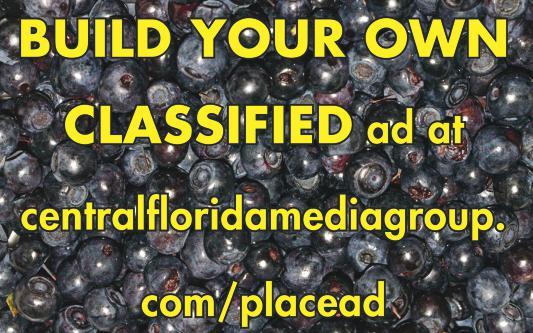
MY PAYROLL SOLUTIONS LLC has over 18 years of experience in matching small businesses, Agriculture Companies and harvesters to staffing services and employee leasing companies which provide payroll services with workers comp coverage for our clients and providing assistance with H2A applications. For more information contact Jeff H Futch at 863 835-1130

EQUIPMENT FOR RENT
FOR RENT
7 yard rowmulcher, Great for replenishing bark on Blueberry Farms, PTO drive, 30hp tractor needed. Call 863-604-2526 for rental


PRODUCTS & SERVICES
AGRI-SOURCE
Producer of Blueberry Pine Bark Products for the Blueberry Industry. 352-351-2700
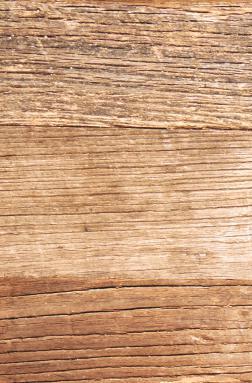
AGRISTARTS
Producers of tissue culture 72ct liners and 21ct field-ready plants. Licensed for all UF selections + more! 407-889-8055
AIRTEC SPRAYERS
Over the Row Blueberry Sprayers Lower Volumes, Less Drift, Better Coverage. 863-412-6247 AirtecSprayers.com
BIGGER BERRIES LLC
Suppliers for Alzchem and Dormex. Call Ryan Atwood at 1-352-267-3229 or John Strickland at 1-912-520-0220 To learn more visit www.FruitFormity.com
BIOBEST
Biobest bumblebees maximize pollination for a better fruit set. 1-855224-6237
CARDEN & ASSOCIATES, INC.
863-291-3505
Here for the Florida Blueberry Grower…yesterday, today and tomorrow!
DUNDEE GROWERS ASSOCIATION
Harvesting, Packing & Marketing services since 1924. (863) 439-1574 / Dun-D.com

EVERGLADES EQUIPMENT
12 locations in Florida with the Best Lease Program in the Business!
A John Deere Dealer ShopEFE.com
FARM CREDIT OF CENTRAL FL 866-824-5626 Patronage refunds for Smart Farmers and Country Home Owners. Lower costs!
FARMING INNOVATION LLC
Hedging and Topping of Blueberries, Peaches, and Olives. HunterVickers 863-287-2351 vickershunter@yahoo.com
FIELDS EQUIPMENT CO., a John Deere Authorized Dealer. 3 Locations. Small Dimensions, Big Performance. (863) 967-0602 / FieldsEquip. com
FLORIDA FOUNDATION SEED PRODUCERS, INC.
352-392-9446
Providing Superior Plant Varieties
ISLAND GROVE
352-274-3835
Quality Plants. Superior Service. IslandGroveAgProducts.com
ORCHARD-RITE
performance wind machines are pure and powerful (509) 834-2029 / Orchard-Rite.com
Southern High Bush Plants For Sale. Avanti, Optimus, Colossus, Arcadia, and Sentinel. Liners, Quarts, and Gallons. Quantity Discounts Available and PreOrder Discounts.
For Orders & More Information, Contact Cameron at (407) 401-4434 or email to cameron@ wildgoosefarms.net
PALOGIX INTERNATIONAL
Plastic rentals, logistic & management solutions. Palogix.com
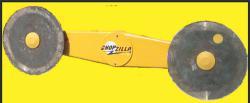
PERFORMANCE NUTRITION
Empower your soil with soil innoculants and protect against stress (732) 888-8000 • pnfertilizers. com
Blueberry equipment and supplies.
PINE BARK FOR SALE
Blueberry Growers Only, H&A Farms, Call Diego Vargas at 407-625-6436 or email Diego. Vargas@HandAFarms.com
PLANT FOOD SYSTEMS
Advanced Plant Nutrition and Protection. PlantFoodSystems. com
400 perforated field trays,100 new field pails, Kuboto B7300, Jacto 200 sprayer, hand hedgers, 2 row fertilizer spreader, Wobble sprinkler heads, and a Perkins 6 cylinder with pump. Call 727-278-1105
FloridaBlueberryGrowers.org The Blueberry News | 33
topic of the season
continued from page 26
TABLE 2. INSECT AND MITE PEST MANAGEMENT OPTIONS, CONT.
should protect berries from the start of oviposition until the last berries are harvested. Malathion provides


not apply more than 17.9 oz of Delegate or 0.28 lb a.i. spinetoram per acre per season.
WG may be applied as needed. Delegate® WG should be applied in the early morning. It is toxic to bees in the surrounding areas for the first 3 hours after application.
Acetamiprid (Assail® 30SG) 2.4 oz +++ 12 h 1 day Do not make more than four applications per season. Toxic to bees until spray is dry (approximately 3 hours).
Malathion (Malathion 57 EC) 2 pt ++ 12 h 1 day Malathion should be applied in the early morning or late evening to reduce the disruption of beneficial insects.
Spinosad (Entrust®) (labeled for organic use)
Flupyradifurone (Sivanto® 200 SL)
Tolfenpyrad (Apta®)
Diaprepes (Citrus root weevil)
1.25–2 oz +++ 4h 3 days It is toxic to bees in the surrounding areas for the first 3 hours after application.
2–4 fl oz/acre +++ 4h 3 days Minimum interval of 7 days between applications.
fl
++++ 12 h 3 days Apply by ground only. Maximum of 3 applications per season or 81 fl oz/acre/season.
days
Bifenthrin (Brigade® 2 EC) 10–16 oz/acre +++ 12 h 1 day Foliar spray for control of adults.
Fenpropathrin (Danitol® 2.4 EC) 8–10 fl oz/acre +++ 24 h 3 days Foliar spray for control of adults.
Thiamethoxam (Actara®) 3–4 oz +++ 12 h 3 days Foliar spray for control of adults. Actara® and Platinum® are neonicotinoids and should not follow each other in a rotation program.
Thiamethoxam (Platinum®) 5–12 fl oz +++ 12 h 75 days
For larval control by directly drenching the soil area beneath the plant canopy or by applying through drip or microjet irrigation systems. Actara® and Platinum® are neonicotinoids and should not follow each other in a rotation program.
Bifenthrin (Brigade® 2 EC) 10–16 oz ++++ 12 h Do not as a soil drench during harvest.
For larval control by directly drenching the soil area beneath the plant canopy or by applying through drip or microjet irrigation systems. Do not use as a soil drench during harvest.
continued on page 36
34 | The Blueberry News FloridaBlueberryGrowers.org
Disease/ Pest Problem Management Options Amount of Formulation per Acre Effectiveness (Least = + to most = +++++) REI (restricted entry interval) PHI (postharvest interval) Comments Blueberry maggot Malathion (Malathion 57 EC) 1.5 pt +++ 12 h 1 day BBM
Diazinon (Diazinon AG500) 1 pt/100 gal ++++ 24 h 7 days Allow 14 days between applications. Spinetoram (Delegate® WG) 3–6 oz +++ 4h 3 days
Tolfenpyrad (Apta®) 27 fl oz/acre ++ 12 h 3 days Allow 14 days
Spirotetramat (Movento®) 8–10 fl oz/acre +++ 24 h 7 days Minimum interval of 7 days between applications.
thrips Spinetoram (Delegate® WG) 6 oz +++ 4h 3 days Delegate®
sprays
5–7 days of residual control.
Do
between applications.
Chilli
27.0
oz/acre
Novaluron (Rimon® 0.83EC) 20–30 fl oz/ acre ++ 12 h 8
MEMBERSHIP INFORMATION
To join or renew your membership in the Florida Blueberry Growers Association, mail a check payable to: FLORIDA BLUEBERRY GROWERS ASSOCIATION, INC. P.O. Box 358086 Gainesville, FL 32635

•Grower Member: $150 (Florida & out-of-state growers)
Additional Associate Member/Grower: $50 each
•Allied Member: $200 (equipment and chemical companies, etc.)












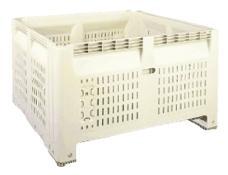

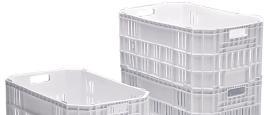


Additional Associate Member/Allied: $50 each
•Educational & Research Member: $10 (University and USDA members who do not grow blueberries commercially)


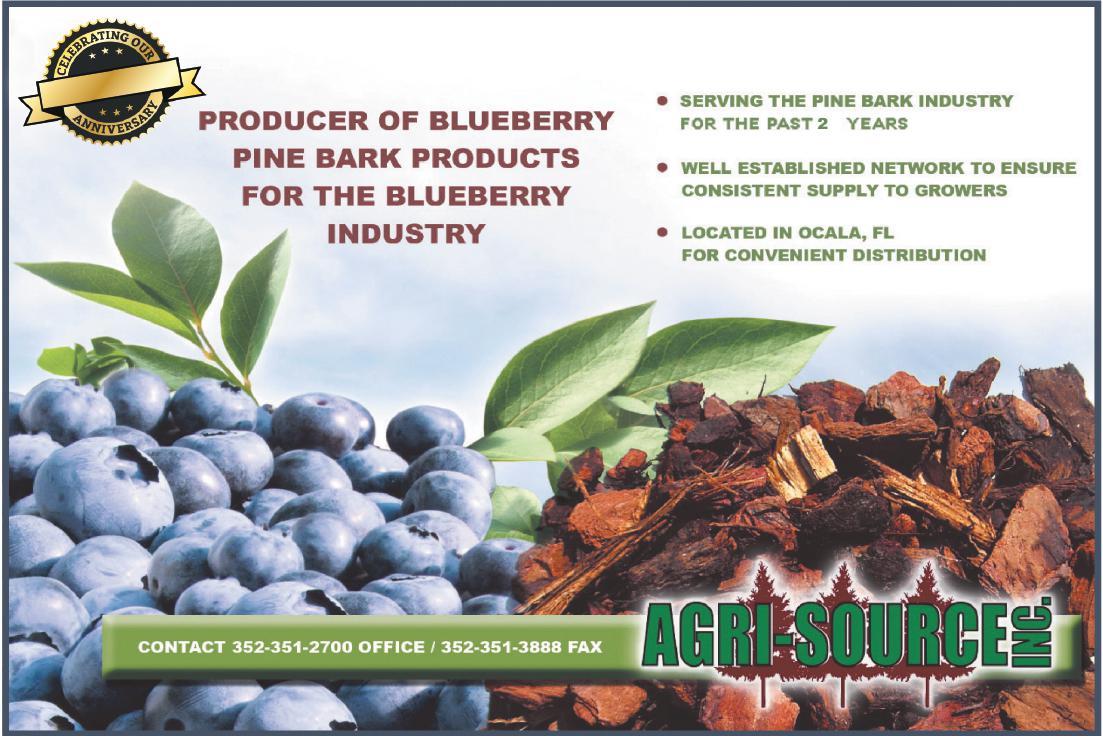
FloridaBlueberryGrowers.org The Blueberry News | 35 Plastic Rentals, Logistic & Management Solutions ■ Daily Bin Rental On-Demand — No Minimum Quantity or Timeframe ■ Citrus Bins, Blueberry Lugs, Peach Tote Rentals ■ Bin Repairs ■ Recycle Program Jerry Cummings 863-651-5596 jcummings@palogix.com www.palogix.com CONNECT WITH US • Content Marketing • Niche Publishing • Social Media Management • Content-Focused Website Development • Targeted Marketing • Articles, Whitepapers, E-Books, Reference Guides, Workbooks, and more. centralfloridamediagroup.com (863) 248-7537 info@centralfloridamediagroup.com
“We are an agricultural services advertising company that helps your business attract clients.”
– Nelson Kirkland, founder, Central Florida Media Group
topic of the season
continued from page 34
TABLE 2. INSECT AND MITE PEST MANAGEMENT OPTIONS, CONT.
Diaprepes (Citrus root weevil)
Flatheaded borer
For larval control by directly drenching the soil area beneath the plant canopy or by applying through drip or microjet irrigation systems. Imidacloprid (Admire®
days Should not follow rotation with Platinum®. They are both neonicotinoids.

For larval control by directly drenching the soil area beneath the plant canopy or by applying through drip or microjet irrigation systems.
Sevin® is also effective against small to medium-sized caterpillars. Diazinon (Diazinon AG500) 1

Flea
Imported fire ants
Scale
Spider mites
7 days Diazinon is also effective against small to medium-sized caterpillars. Zetacypermethrin (Mustang MaxTM)
4 oz ++++ 12 h 24 h Use a minimum spray volume of 20 gal by ground.
Acetamiprid (Assail® 30SG) 2.4 oz +++ 12 h 1 day Do not make more than four applications per season.
Diazinon (Diazinon AG500) 1 pt/100 gal ++++ 24 h 7 days Mound drench. Slowly apply 1 gal of diluted mixture over and 6 inches around each mound. Apply gently to avoid disturbing ants.
Pyriproxyfen (Esteem® 0.86 EC Ant Bait)
Methoprene (Extinguish® Professional Fire Ant Bait 0.5%)
1.5–2.0 lb (2–4 tbsp/ mound) ++++ 12 h 24 h Esteem® Ant Bait should be applied during the spring and, if needed, again in the fall. Apply on sunny days when the soil temperature is at least 60°F and the soil is moist. Baits are slow acting but effective. Allow 4 weeks to work. Do not make other imported fire ant treatments for 7–10 days. May need to reapply if heavy, flooding rains occur within 7 days.
1–1.5 lb (3–5 tbsp/ 1000 sq ft) (3–5 tbsp/ mound)
+++ 4h 0 days Extinguish® Professional Fire Ant Bait (0.5% methoprene) is legal for use on crop land. Caution: Extinguish baits with methoprene plus hydramethylnon are not labeled for use on crop land. Application during the heat of the day or when rain is expected within 6 hours of application will reduce the effectiveness of this product. In areas of heavy infestation, repeat applications may be necessary 10–12 weeks after the initial application.
Diazinon (Diazinon AG500) 1 pt/100 gal +++ 5 days 5 days
Pyriproxyfen (Esteem® 0.86 EC)
1.5–2.0 lb
12 h 24 h
Mineral oil (JMS Stylet oil) 25–150 gal ++ 4h 12 h Recommended 1–3 gallons per 100 gallons of water. Avoid using this product if the temperature is above 85°F.
Imidacloprid (Admire® Pro) 10 fl oz +++ 12 h 3 days Foliar application.
Fenazaquin (Magister® SC) 24–36 fl oz ++++ 12 h 7 days Apply in at least 50 gallons of water per acre. Use higher rates for heavier mite pressure. Do not make more than one application per year.
36 | The Blueberry News FloridaBlueberryGrowers.org
Disease/ Pest Problem Management Options Amount of Formulation per Acre Effectiveness (Least = + to most = +++++) REI (restricted entry interval) PHI (postharvest interval) Comments
Fenpropathrin (Danitol® 2.4 EC) 10–16 oz +++ 24 h 3 days
2.1–2.8
+++ 12 h 3
Pro)
oz
Thiamethoxam
5–12 fl oz +++ 12 h
(Platinum®)
75 days
1–2 lb +++ 12 h
++++
beetles Carbaryl (Sevin® 4F)
7 days
pt/100 gal
5 days
+++
topic of the season
TABLE 2. INSECT AND MITE PEST MANAGEMENT OPTIONS, CONT.
grubs (Grubs of Asiatic garden beetle, European and masked chafer, and Oriental beetle)
Yellownecked caterpillars
1.5 pt
Label for organic use. Allow pesticide to dry before bees can forage.
Do not apply when a lot of bees are foraging.
h 3 days Allow 14 days between applications.

days Soil application. Chemigation into root zone through lowpressure drip, trickle, or microsprinkler. It is important to moisten the soil (1/2–1 inch of water) prior to application or shortly after application.
day Foliage-feeding caterpillars become more difficult to control as they mature.

FloridaBlueberryGrowers.org The Blueberry News | 37
Disease/ Pest Problem Management Options Amount of Formulation per Acre Effectiveness (Least = + to most = +++++) REI (restricted entry interval) PHI (postharvest interval) Comments Spider mites Fenpyroximate (Portal®) 2 pt ++++ 12 h 1 day Growers can make two applications per year. Acequinocyl (Kanemite® 15 SC) 31 fl oz +++ 12 h 1 day Do not apply this product through the irrigation system. Allow a minimum of 21 days between applications. Horticultural oil (JMS Stylet-Oil®) 3–6 qt/100 gal ++ 4h 0 days Avoid using this product if the temperature is above 85°F. Horticultural oil (Stoller Golden Pest Spray Oil) 2 gal (low volume) application or 2 gal/100 gal (dilute spray) ++ 4h 0 days Avoid using this product if the temperature is above 85°F. Spotted wing drosophila Zetacypermethrin (Mustang MaxTM) 4 oz ++++ 12 h 24 h Use a minimum spray volume of 20 gal by ground. Spinetoram (Delegate® WG) 6 oz +++ 4h 3 days Delegate® WG is toxic to bees until it is thoroughly dry. Malathion (Malathion 57 EC) 1.5 pt ++++ 12 h 1 day Cyantraniliprole (Exirel®) 13.5–20.5 oz +++ 12 h 3 days Minimum application interval between treatments is 5 days. Fenpropathrin (Danitol® 2.4 EC) 10.6–16 oz ++++ 24 h 3 days Do not make more than two consecutive applications. Rotate with insecticides from different classes. Bifenthrin (Brigade® 2 EC) 5.3–16 oz ++++ 12 h 1 day Do not make more than two consecutive applications. Phosmet (Imidan® 70-W ) 1.3 lb ++++ 1 day 3
Spinosad (Entrust®) (labeled for organic use) 1.25–2 oz +++ 4h 3 days
Acetamiprid (Assail® 30 SG) 4.5–5.3 oz +++ 12 h 1 day
Tolfenpyrad (Apta®) 27 fl oz/acre
12
Imidacloprid (Admire® Pro) 10 fl oz +++ 12 h 7
days
++
White
Malathion
EC)
(Malathion 57
+++ 12 h 1
for your event a week prior. This will provide them with ample time to schedule coverage and have the information they need. Be sure to follow up!
• Host reporters: Even if you don’t hold a community event, invite your favorite reporter to come learn more about blueberries and your farm firsthand — a behind-thescenes look at how blueberries are grown, how long your business has been part of the community, the state of your region’s industry. National Blueberry Month provides the perfect opportunity to get your foot in the door of your local media outlets and establish key relationships that can pay off throughout the year.
CONTACTING THE MEDIA
• Create a Media List: Make a list of newspapers, magazines, TV and radio stations, news-related websites, event calendars and/or blogs in your community. You may want to ask a local organization or the local Chamber of Commerce if they have a list they would share. (Note: You don’t have to go after every news outlet. Pick your favorite two or three and start there.)
Once the research is complete, you’ll be ready to build a media list. Find email addresses, phone numbers, and social media accounts for reporters covering events, local news stories, health, lifestyle, and/or food. Be sure to include assignment editors, producers, and freelance reporters to your list. If you can’t find the specific contact information online, call the outlet’s news desk to get the answers you need. A well-organized spreadsheet will go a long way in keeping everything straight and make outreach easier. Be sure to check back periodically to make sure your list is up to date.

• Know Who You’re Pitching: Once you develop your list, get to know the media outlets and reporters. Read the papers, watch the shows, and listen to the radio stations to get a sense of the reporters’ interests and themes. Start thinking about how your knowledge can help extend the reporters’ subject matter further. When you make your pitch, let the writer know how and where your idea might fit. Think of the idea through the reporter’s eyes — how will this piece be of interest and need to their audience? How will it meet their criteria?
• Timeline for Media Event Outreach: Having a strategy will help keep you on track for a successful media event:
— One to two week(s) prior: Email your media advisory and make follow-up calls to confirm it’s been received. Pitch the story to your local news outlets that would run in advance of the event such as a profile on your business or a preview of the event. Two to three business days before: Resend the advisory to unresponsive media to make sure that you’re still on their radar. Make another round of follow-up calls and ask if they plan to cover the event so you will know to look for them.
— The day of the event: Make note of the name, outlet, e-mail, and phone number to keep track of reporters who come.
— After the event: Follow-up with media that attended to thank them for their time and offer yourself for future media needs. For media that didn’t attend the event, consider sending pictures and a post-event press release. Be sure to share any media coverage you receive on your social media channels!
38 | The Blueberry News FloridaBlueberryGrowers.org USHBC Update, cont. from page 10
_ _____ CREDIT JENNIFER SPARKS, USHBC Contact Jack Green, Blue Labor, LLC. jackgreen4@icloud.com 863-397-9471 • Mulch sales • Container sales • Farm consulting
Are You Licensed?
Blueberry varieties developed by the University of Florida are patent protected under U.S. Code Title 35. Anyone propagating plants for their own use or for sale is required to be licensed by Florida Foundation Seed Producers, Inc. (FFSP). Additionally, packers, marketers, and sellers of fruit from the above varieties can be liable for selling fruit from illegally propagated plants. As of Dec 31, 2021 the above entities are the only entities licensed for legal propagation and sale of plants of the respective varieties. Protect yourself from unknowingly purchasing illegal plants or fruit by asking entities if they are licensed to propagate and if fruit has come from legal plants. Illegal propagation is a direct threat to the blueberry industry and the patent rights held by FFSP. Royalties generated are critical to the support of the Florida blueberry breeding program. If you are interested in obtaining a license or would like to anonymously report illegal propagation, please contact: FFSP, 3760 NW 83rd St, Suite 2, Gainesville FL 32606, Phone: 352- 273-3656. You can also visit http://ffsp.net to learn more about licensing oppportunities.
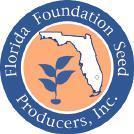
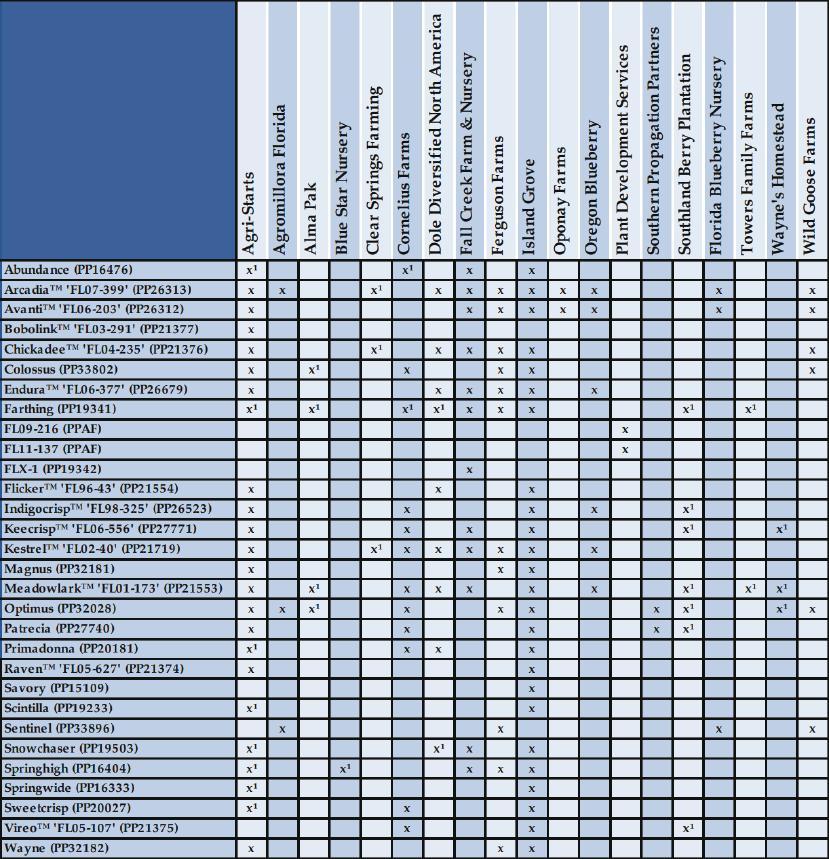
FloridaBlueberryGrowers.org The Blueberry News | 39
x = Licensed for USA x¹ = Licensed for USA (excluding AZ, CA, OR, and WA)
KPHITE® 7LP & Sizer XL work systemically throughout the plant, delivering vital disease protection and nutrients right where the plant needs it. KPHITE® 7LP brings its EPA registered disease protection from its unique, proven fungicide bactericide molecule Sizer® XL provides totally soluble Phosphate and Potassium to encourage consistent fruit set and superior production.
KPHITE® 7LP and Sizer® XL are trusted by growers and proven through independent trials
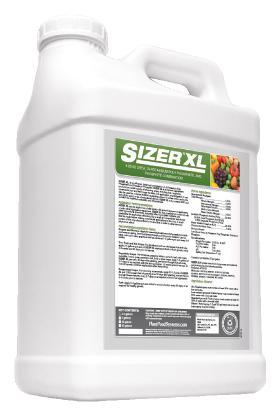

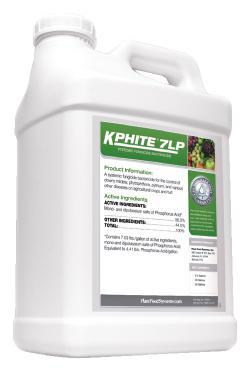
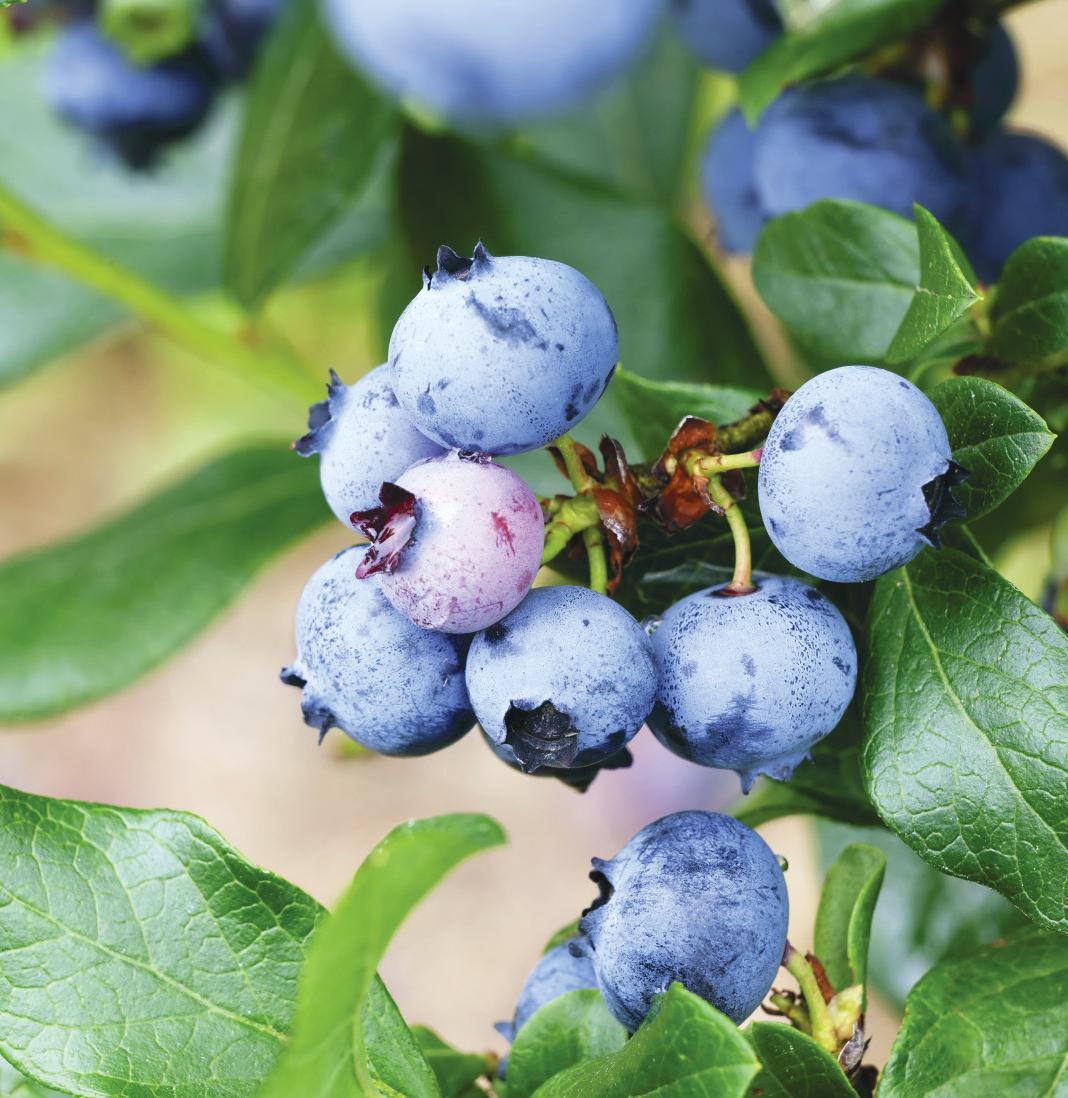
40 | The Blueberry News FloridaBlueberryGrowers.org THE SYSTEMIC COMBINATION FOR A S U P ERIOR B LUEBER R Y CR O P 800 -343 -77 75 • P.O. B OX 7 75 • ZEL LWOO D, FL 3 2798 • PlantFoodSystems com K-PHITE ® 7LP and Sizer® XL are registered trademarks of Plant Food Systems, Inc &


























 Blueberry Growers Association
Blueberry Growers Association





































 Horticultural Sciences
Horticultural Sciences
















































 by DOUG PHILLIPS, UF/IFAS Blueberry Extension Coordinator
by DOUG PHILLIPS, UF/IFAS Blueberry Extension Coordinator
































































